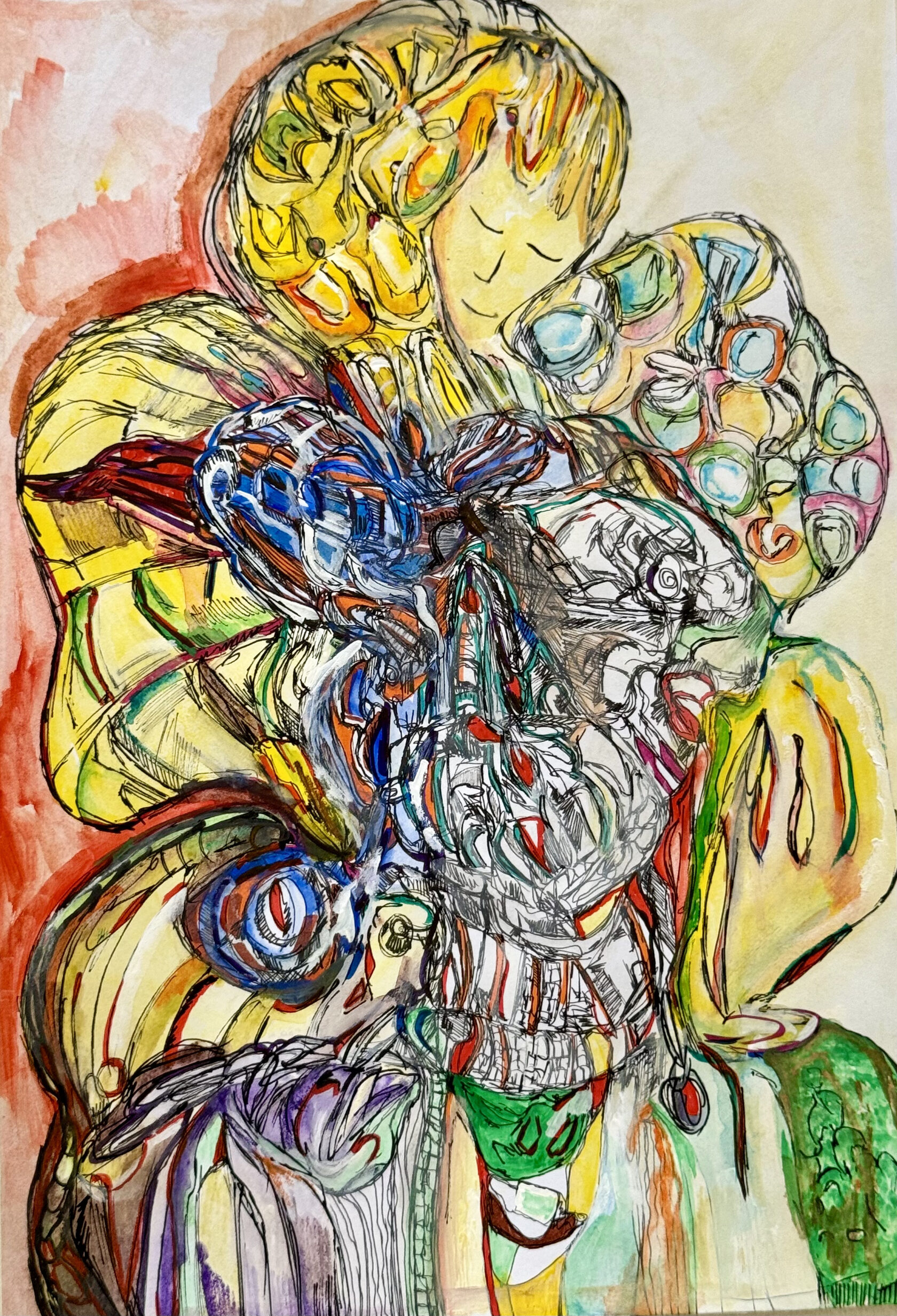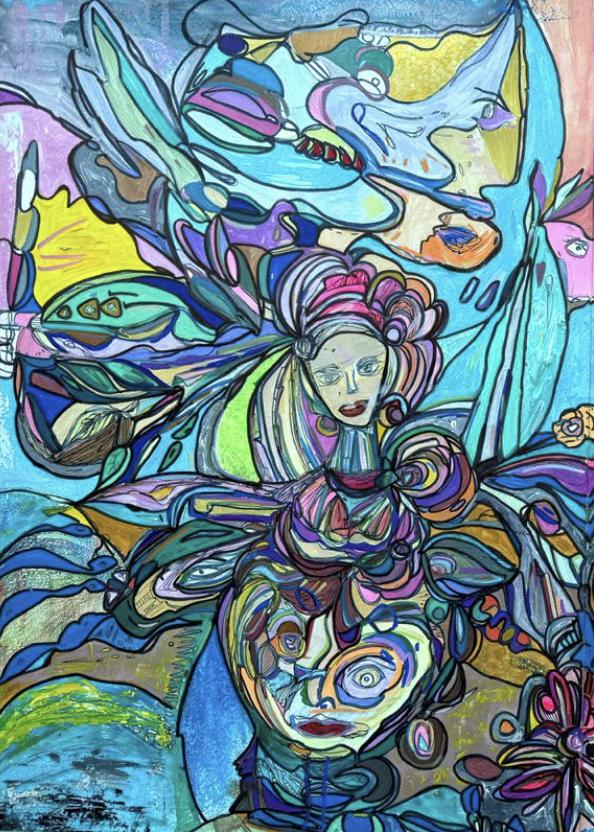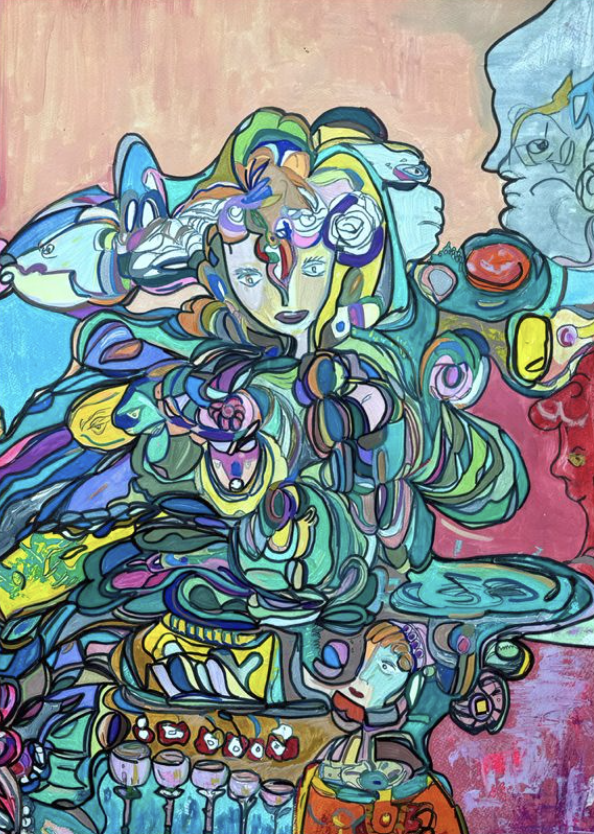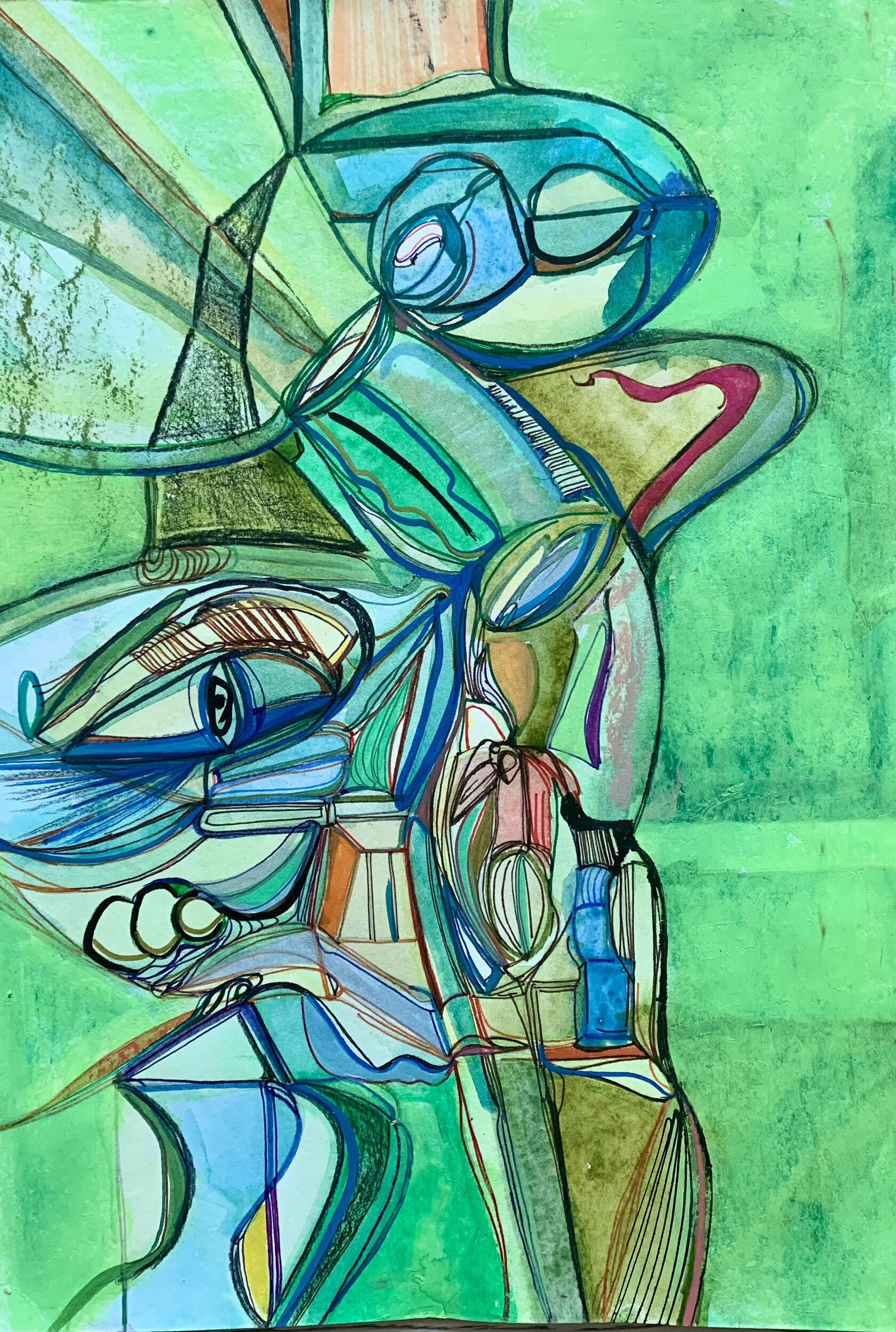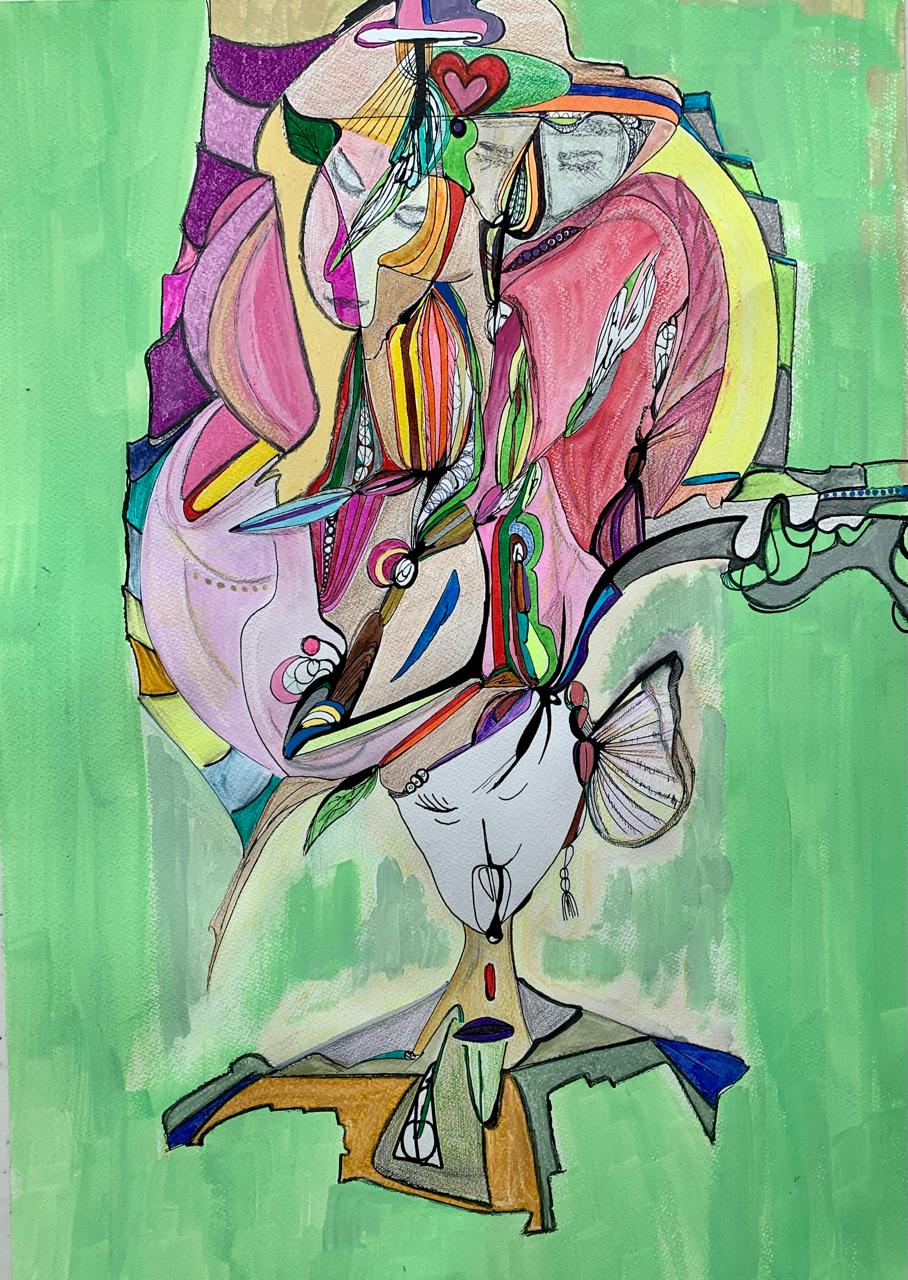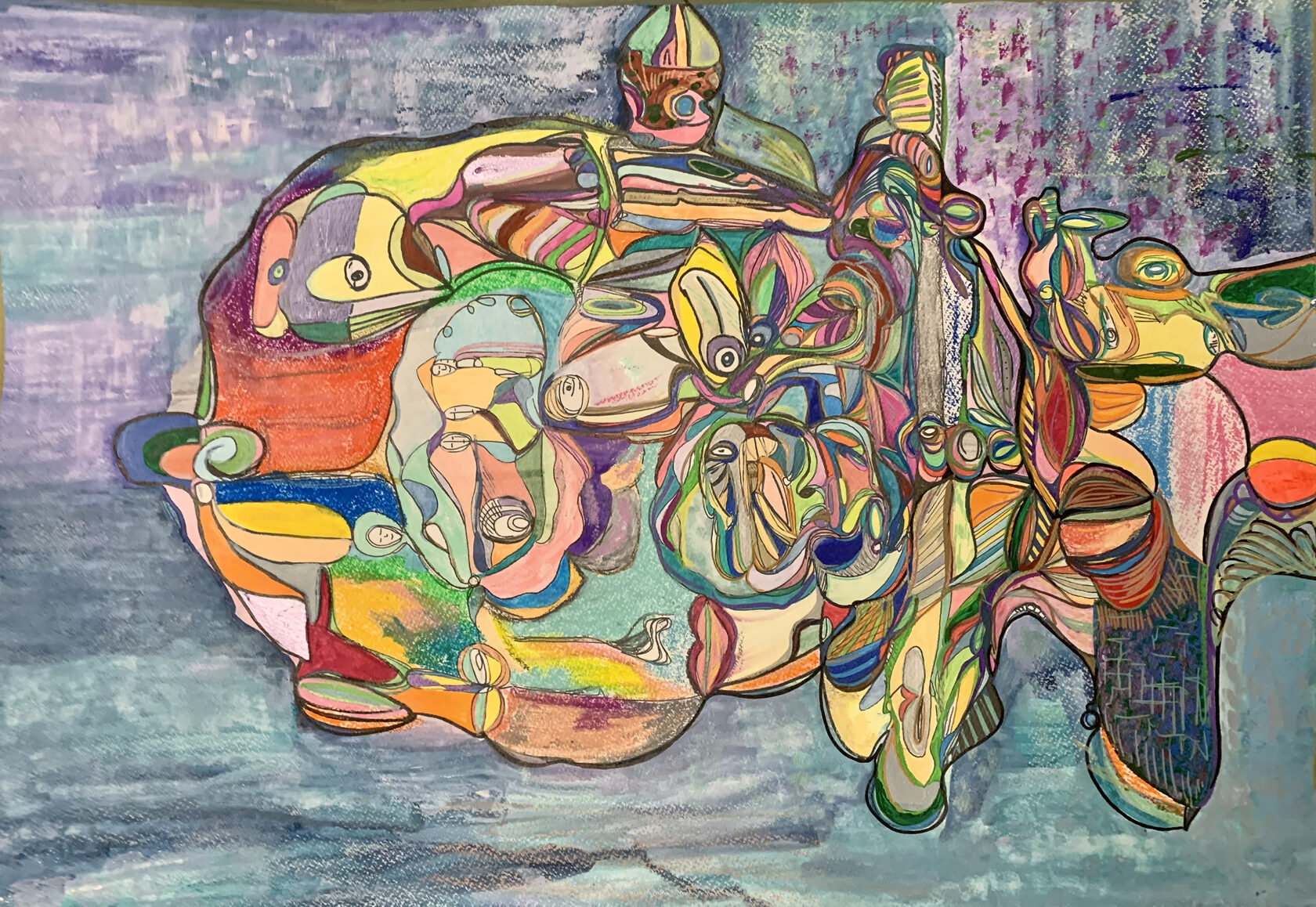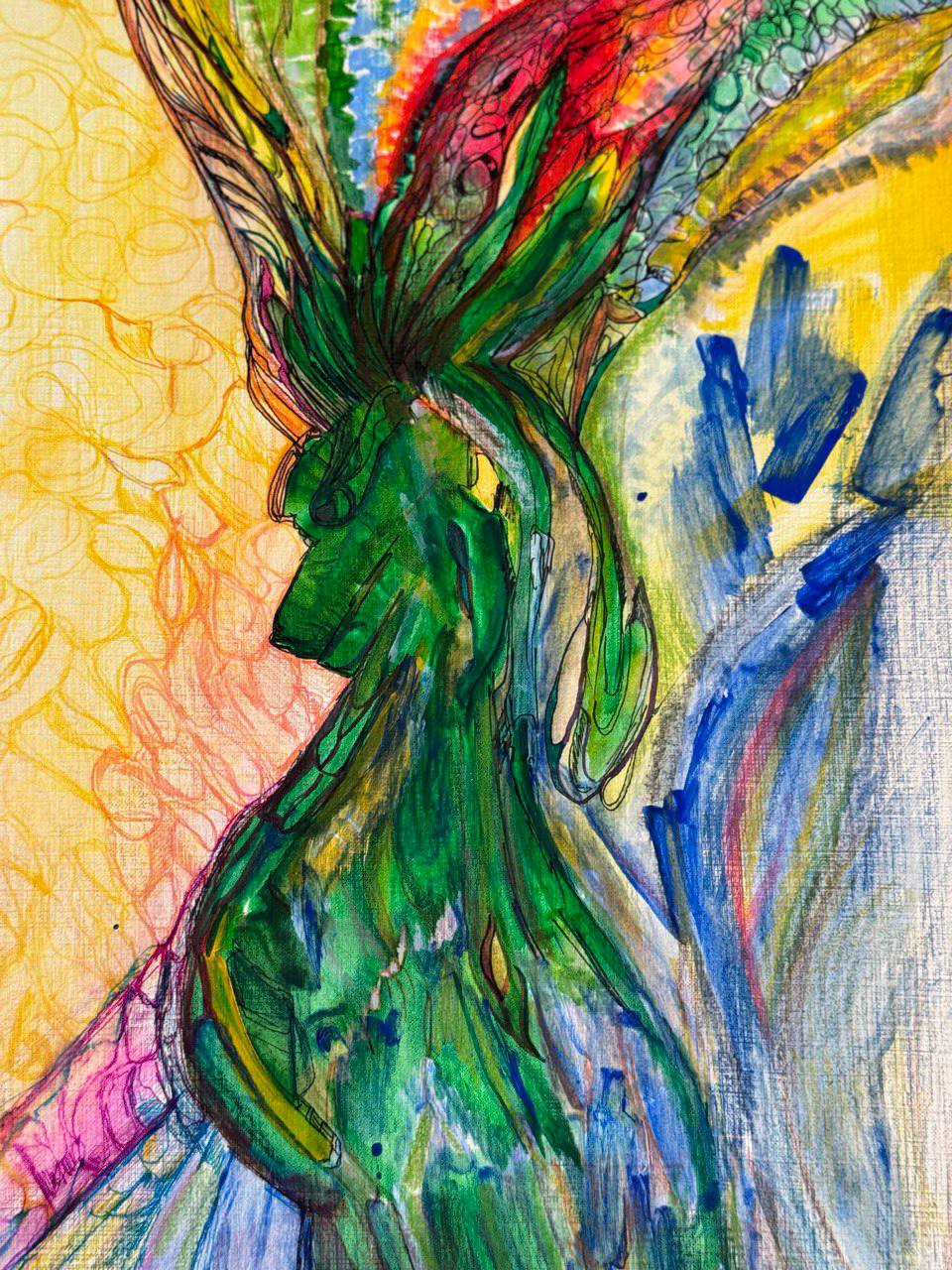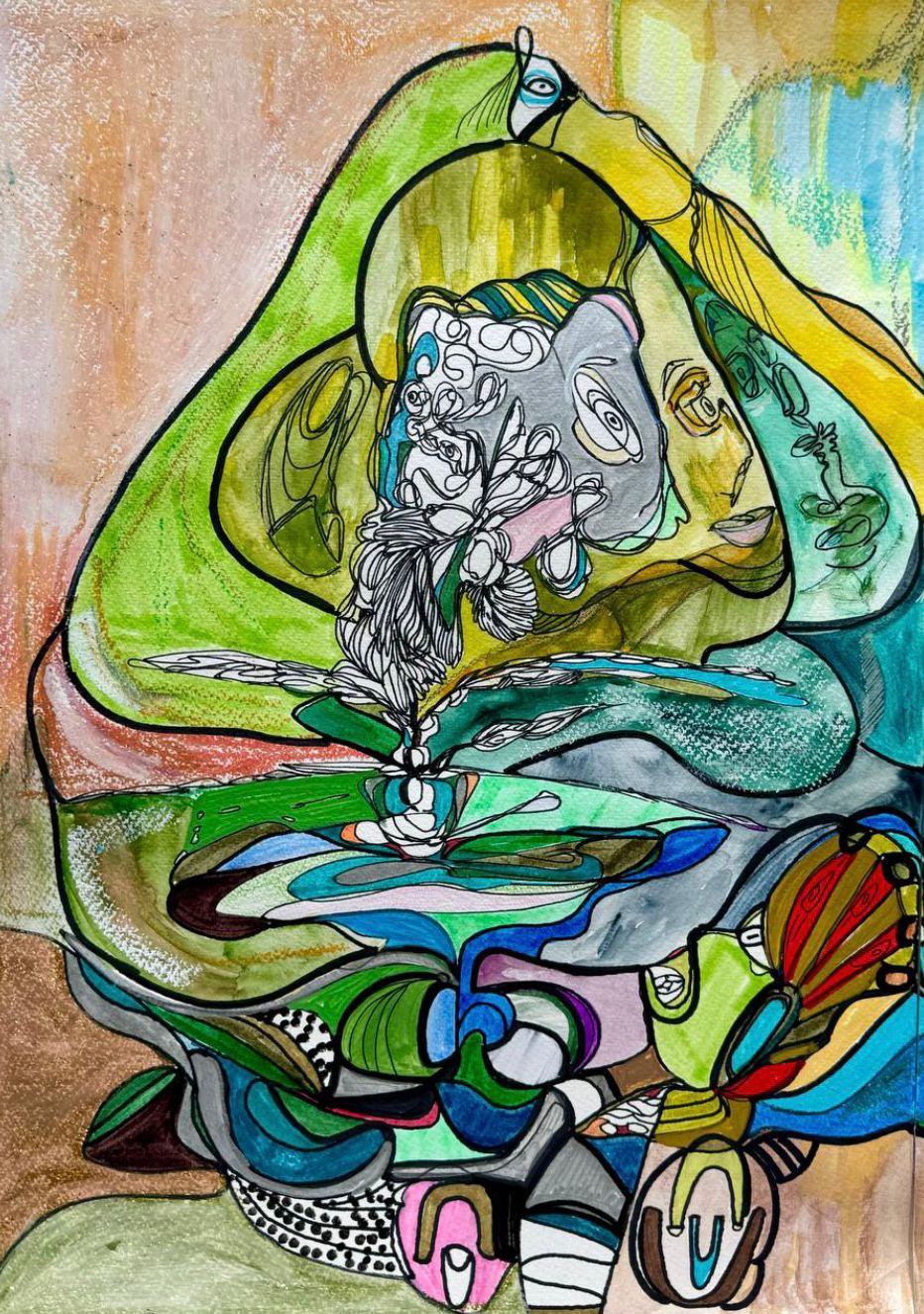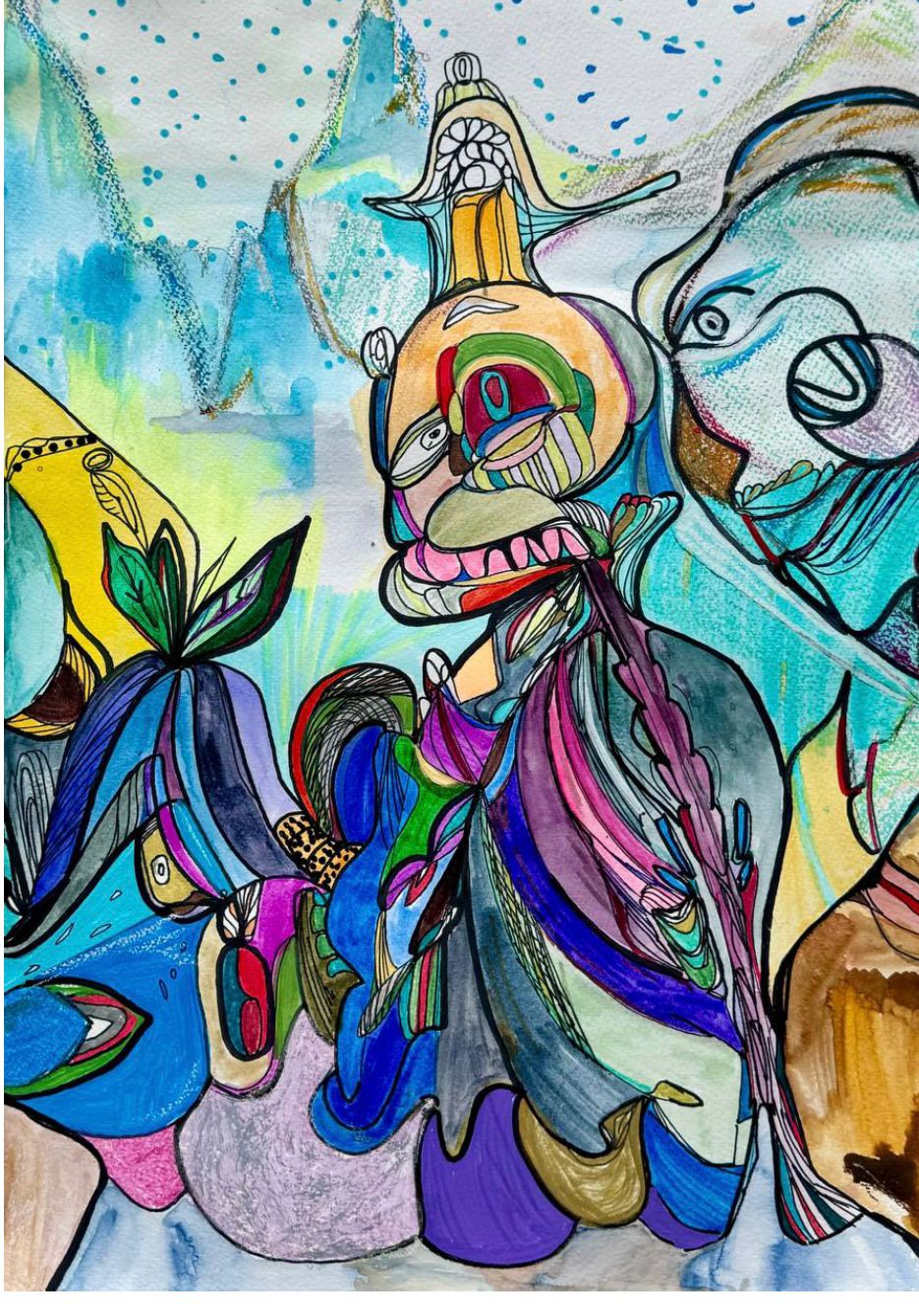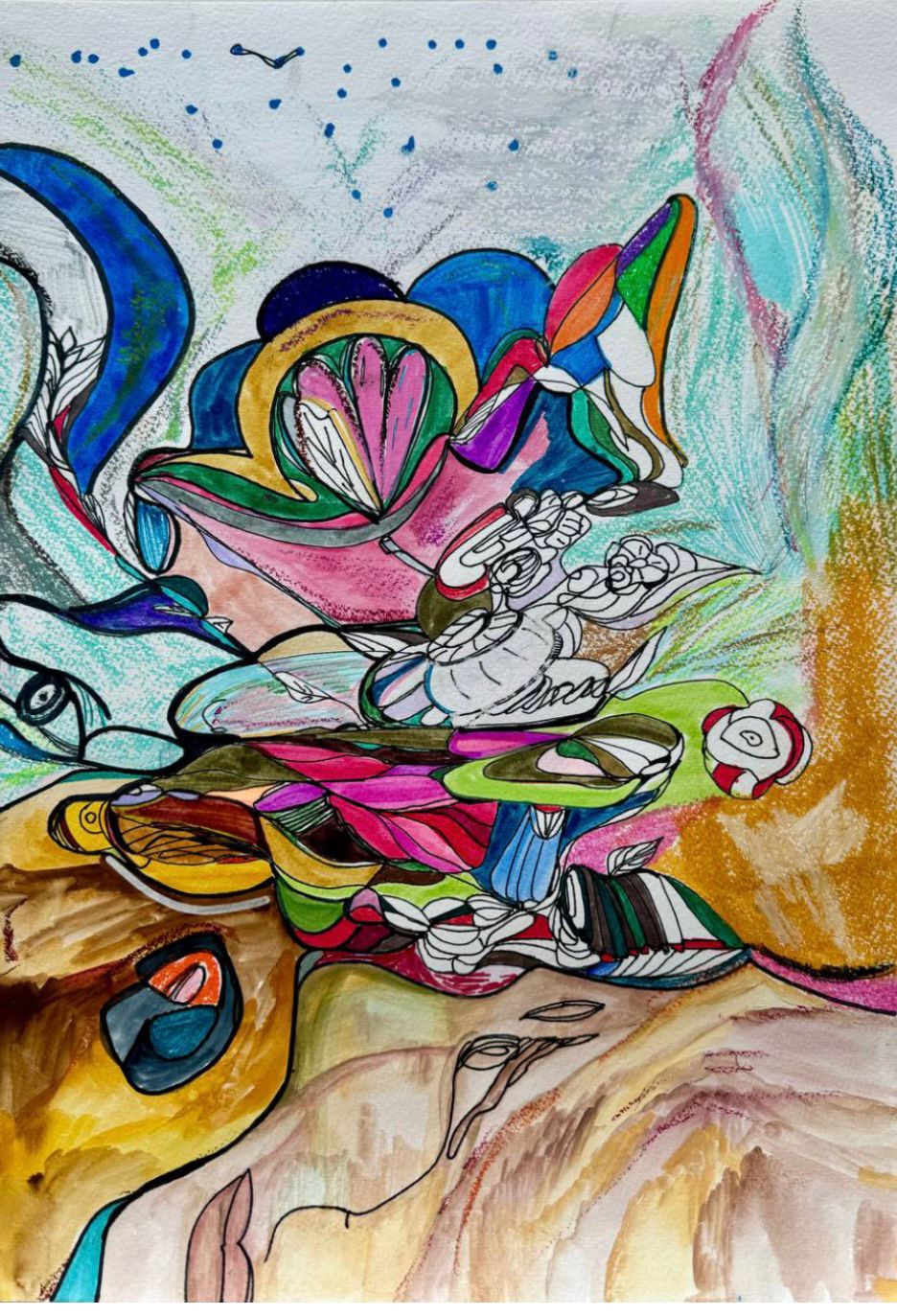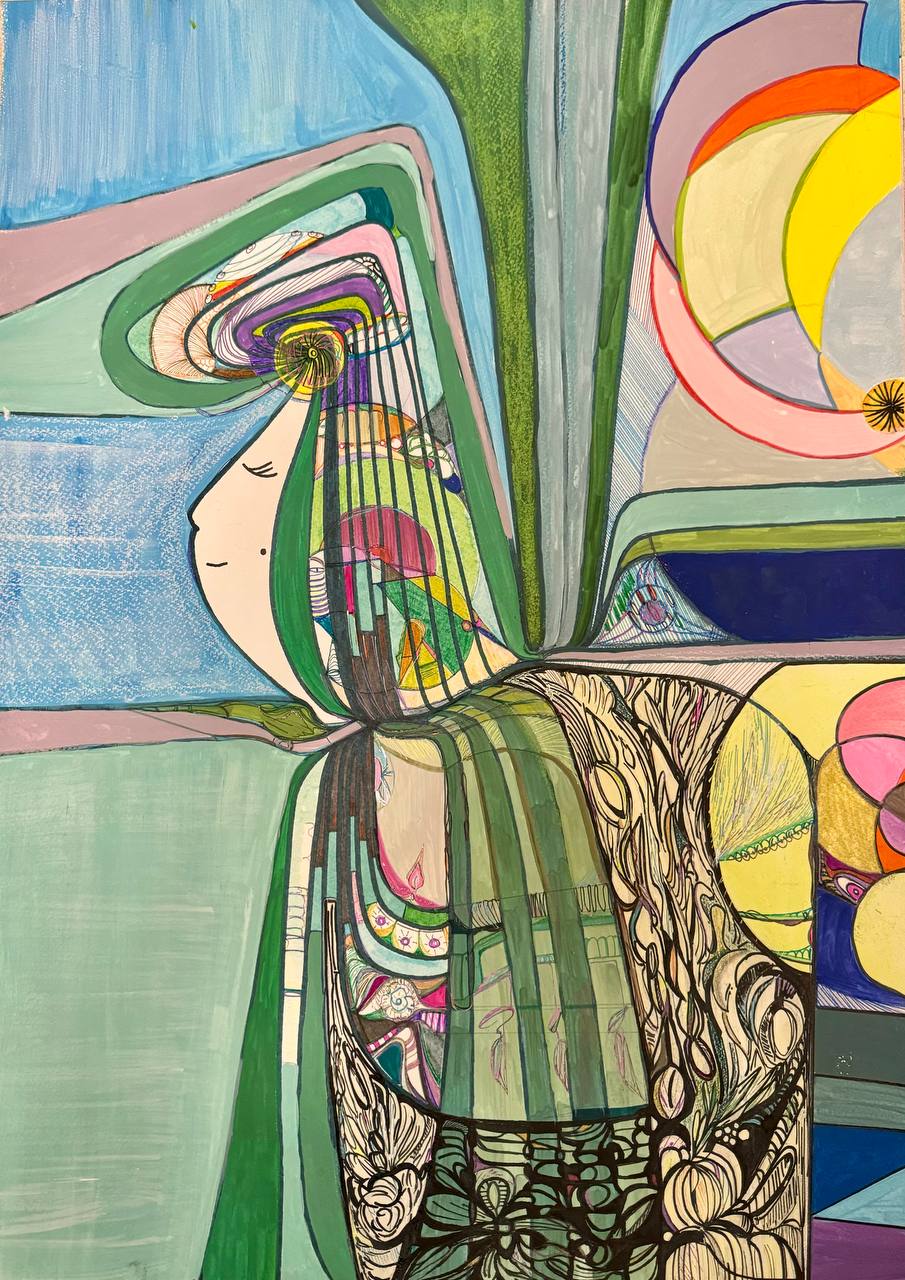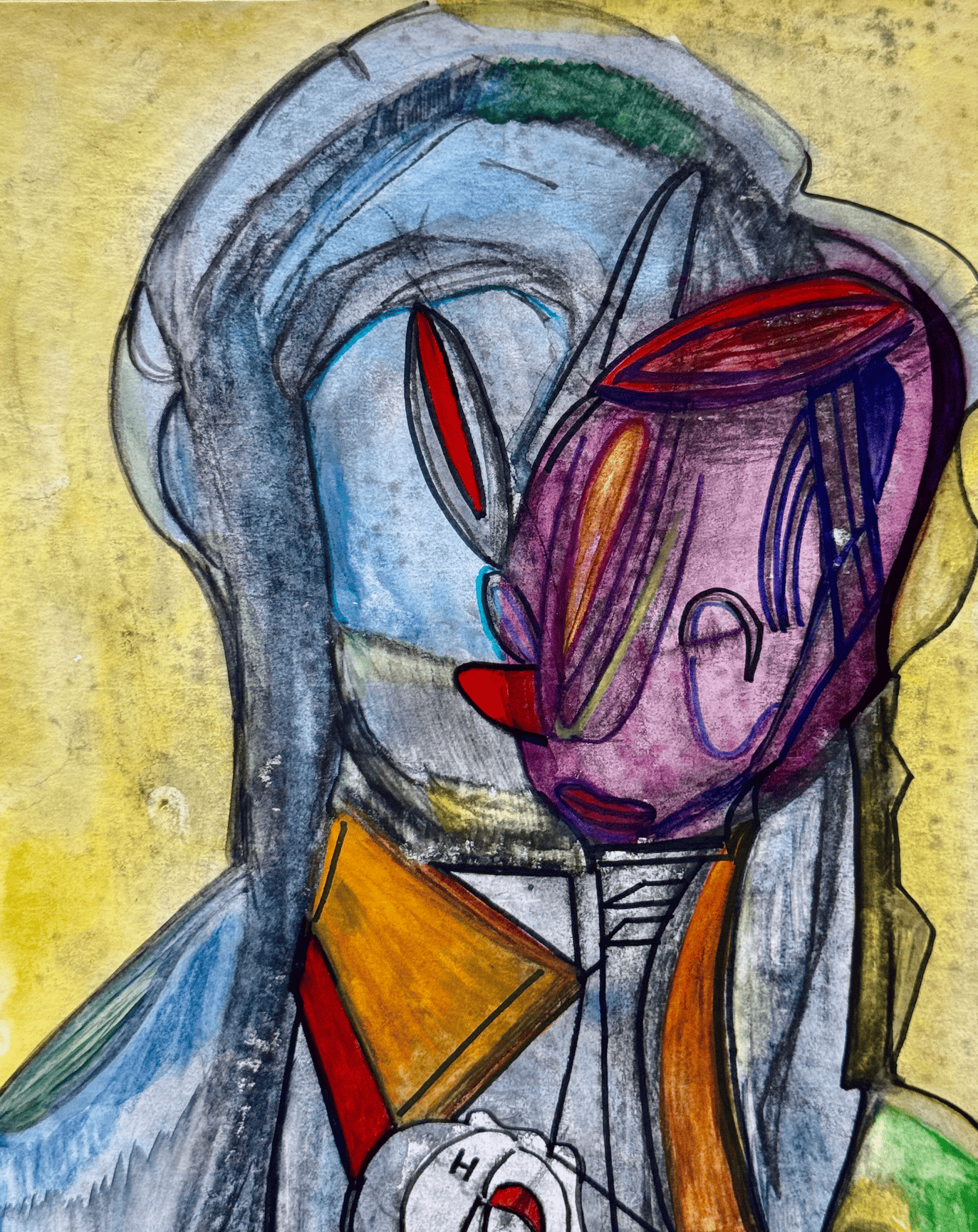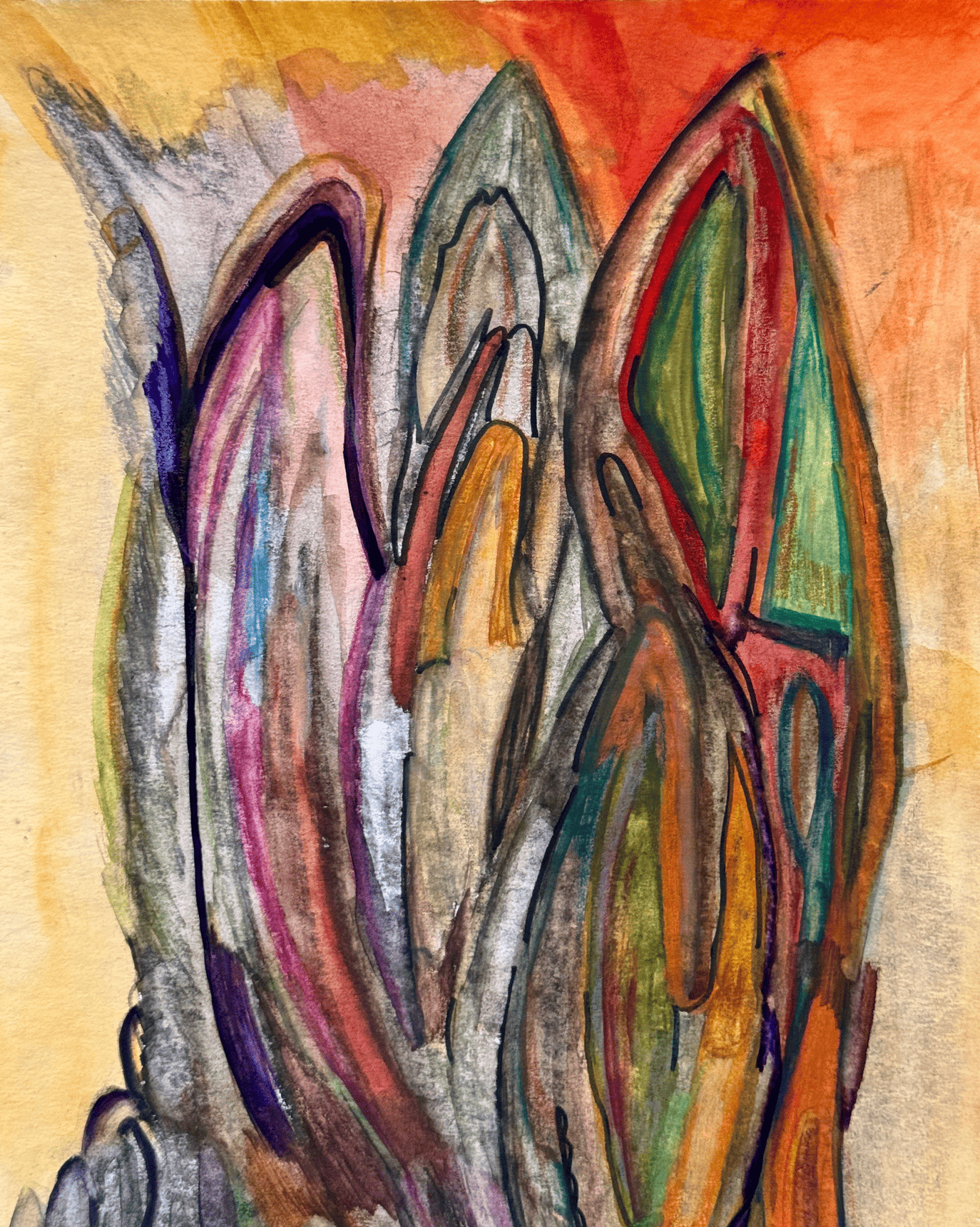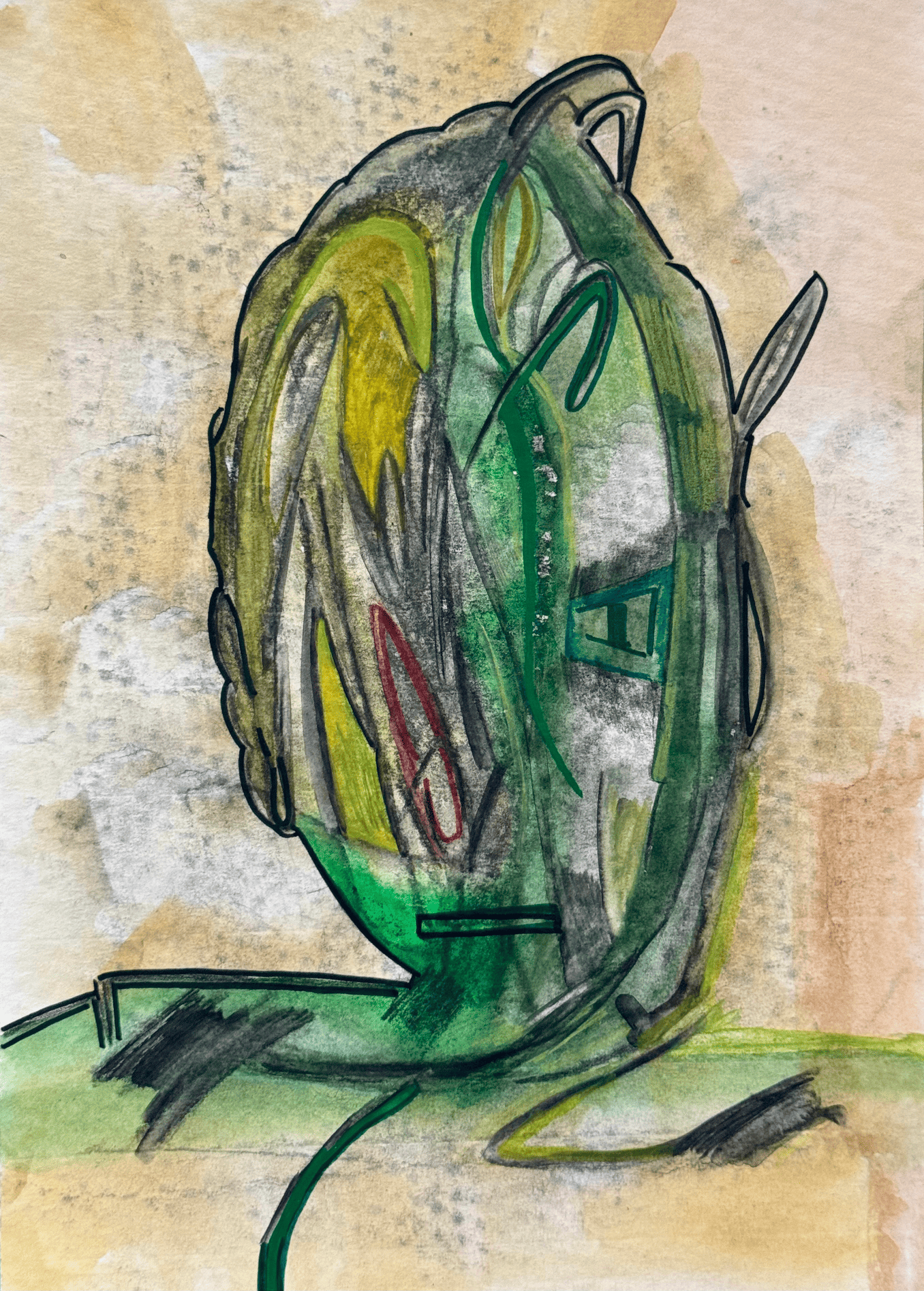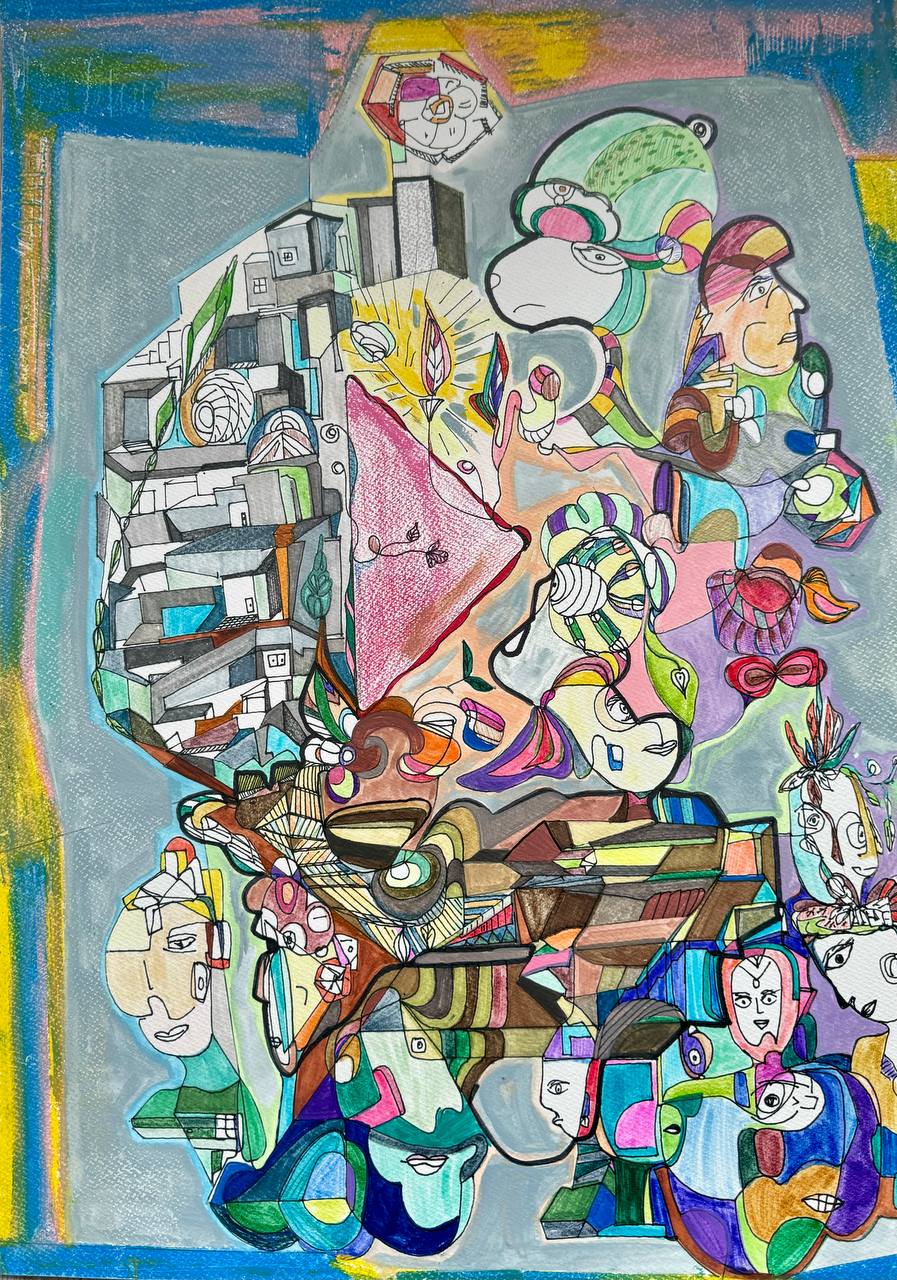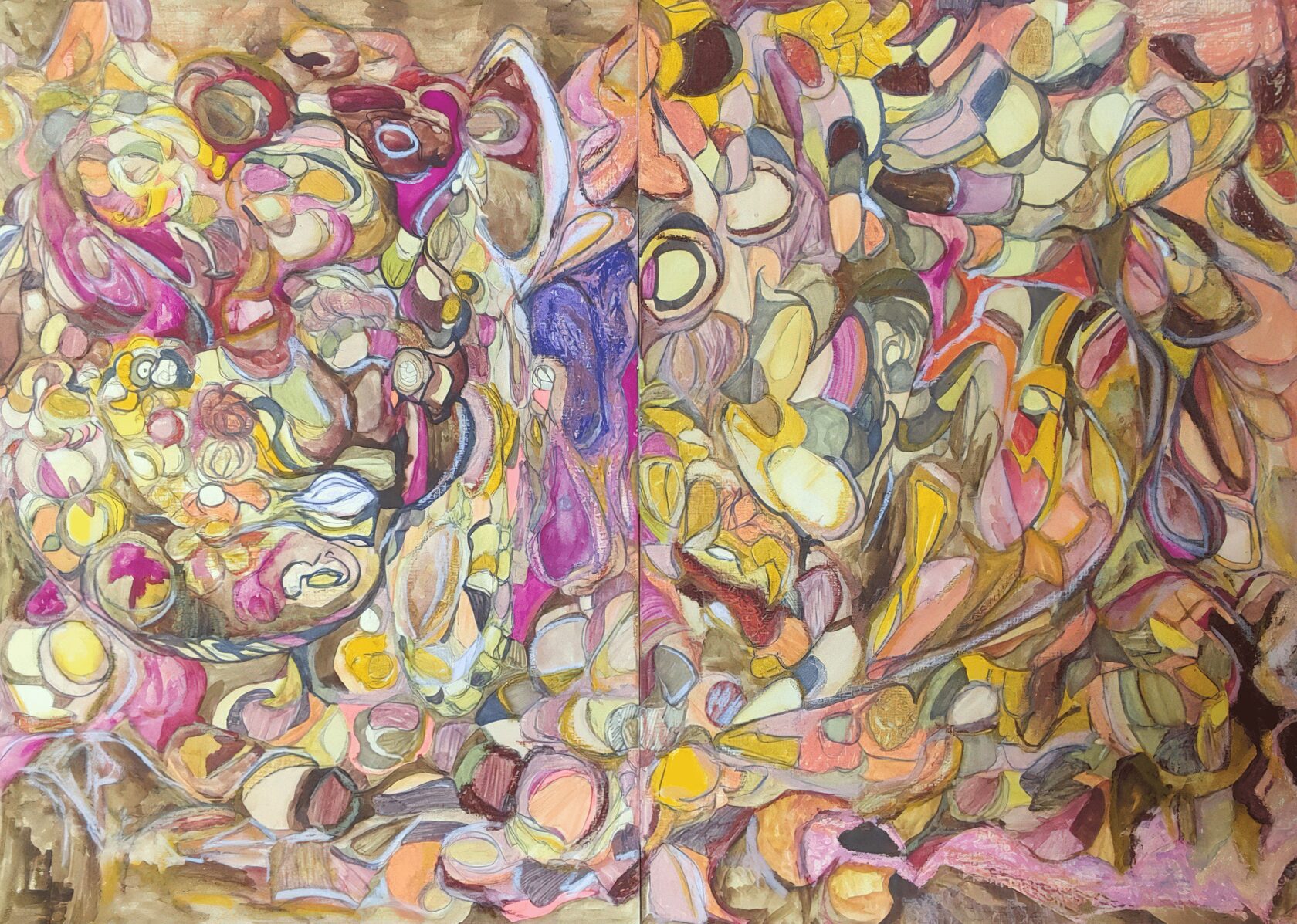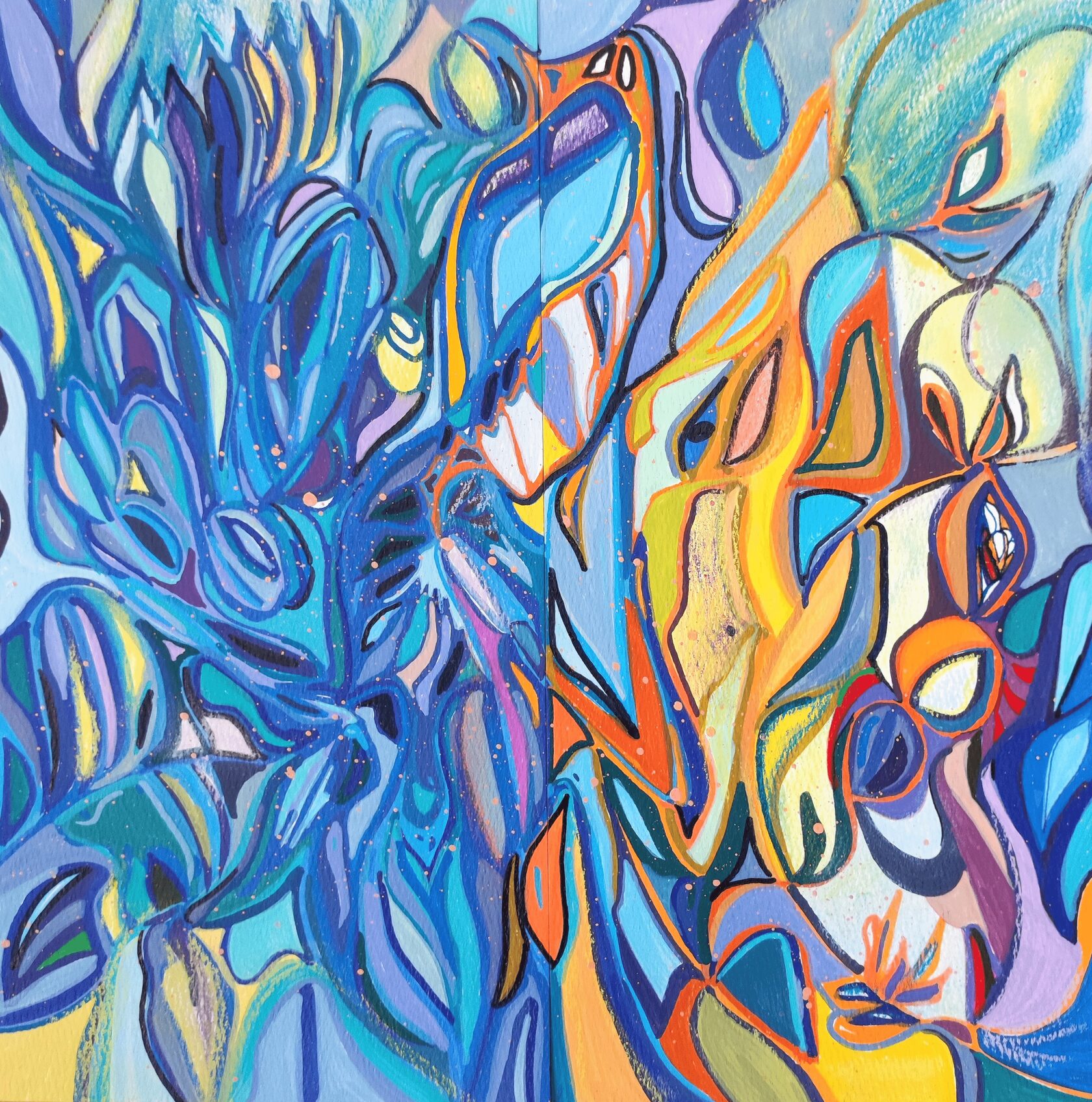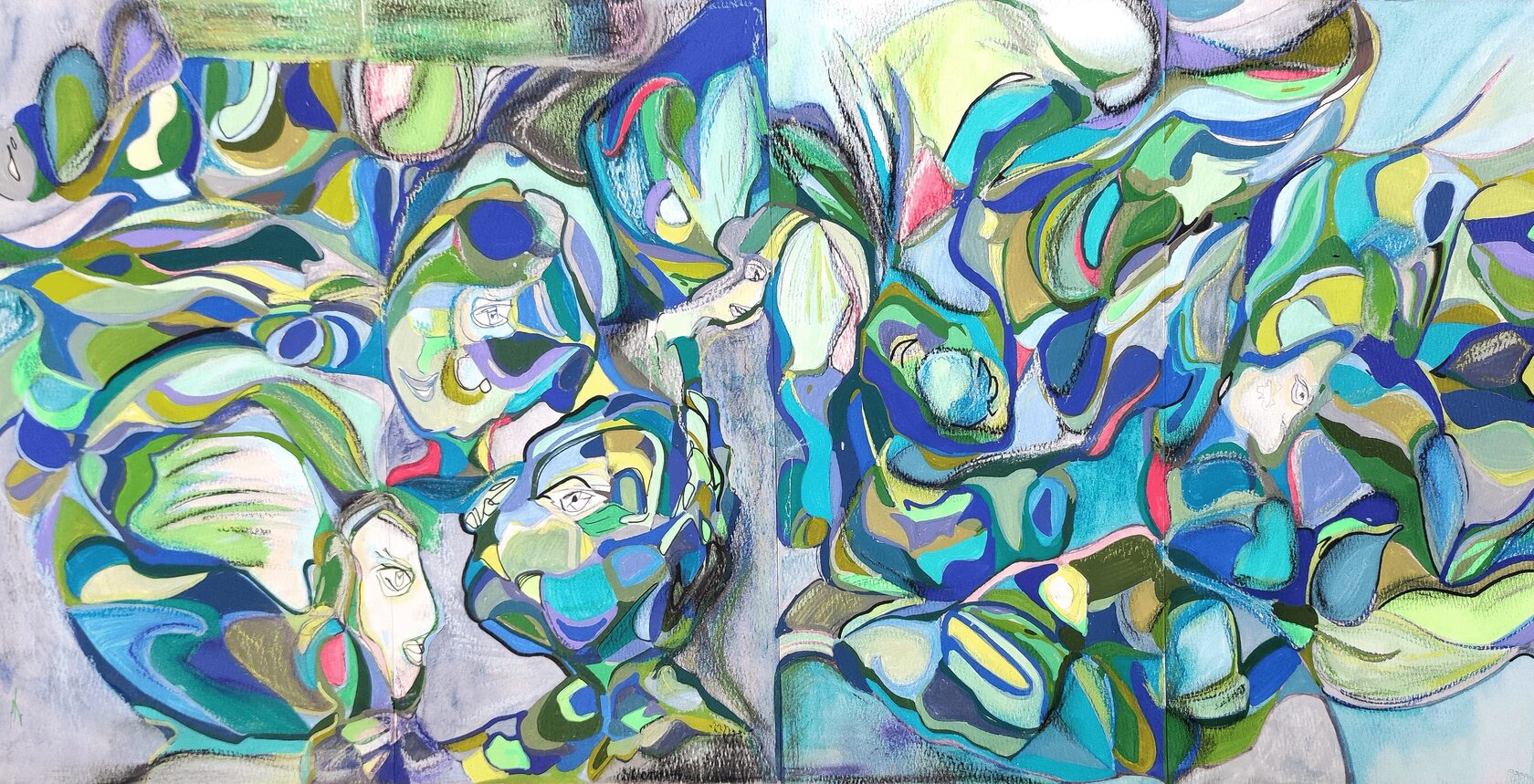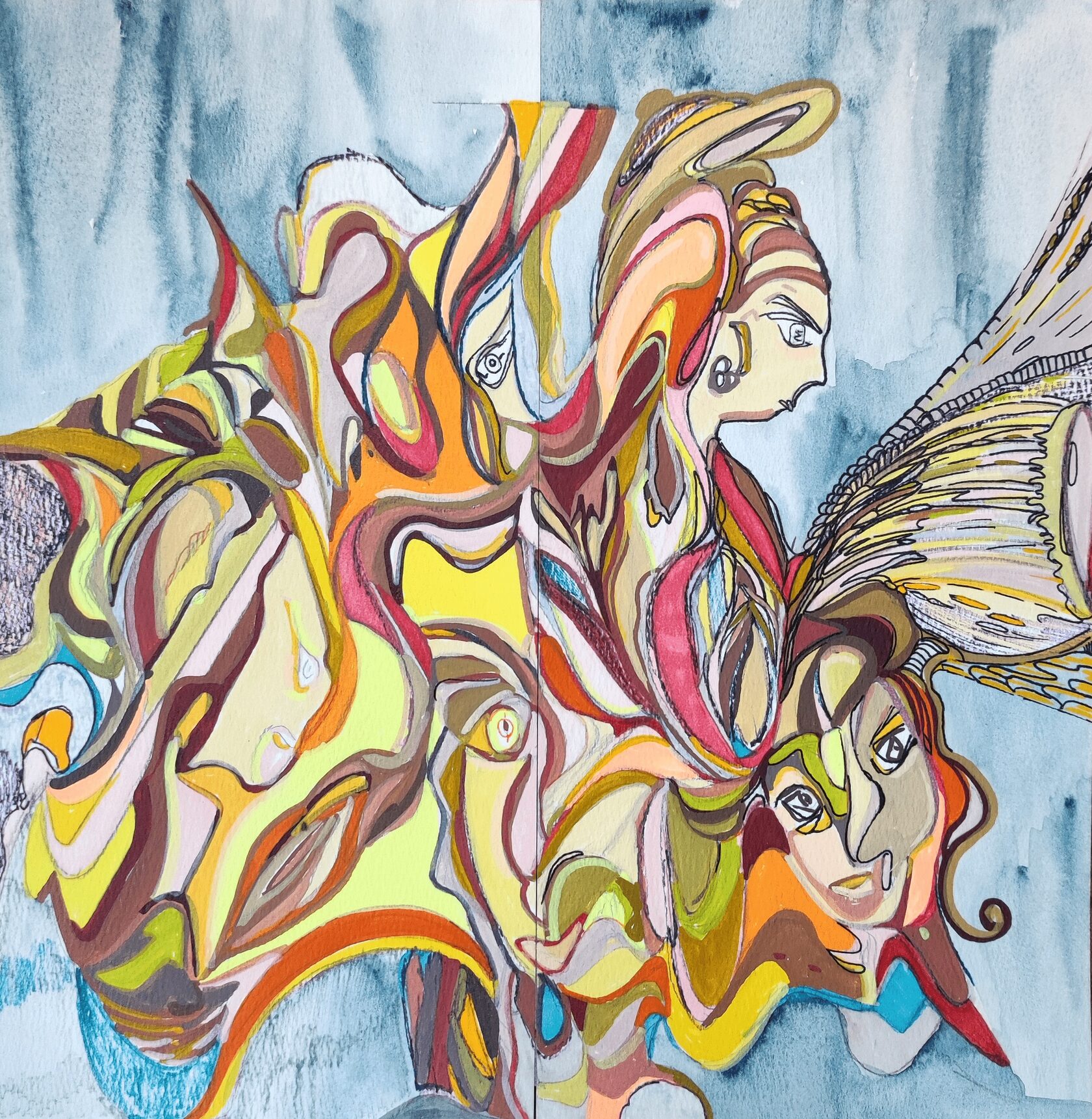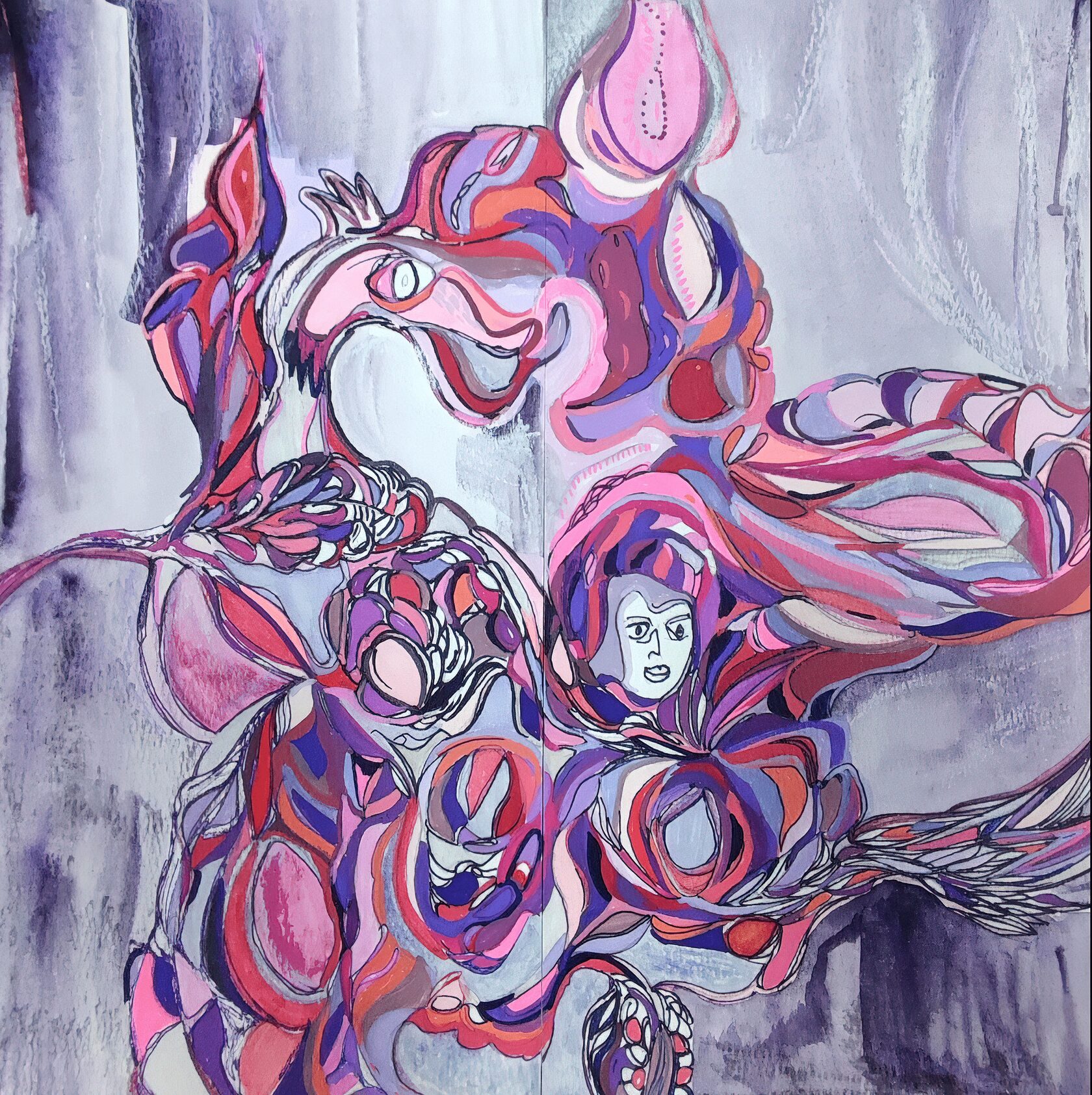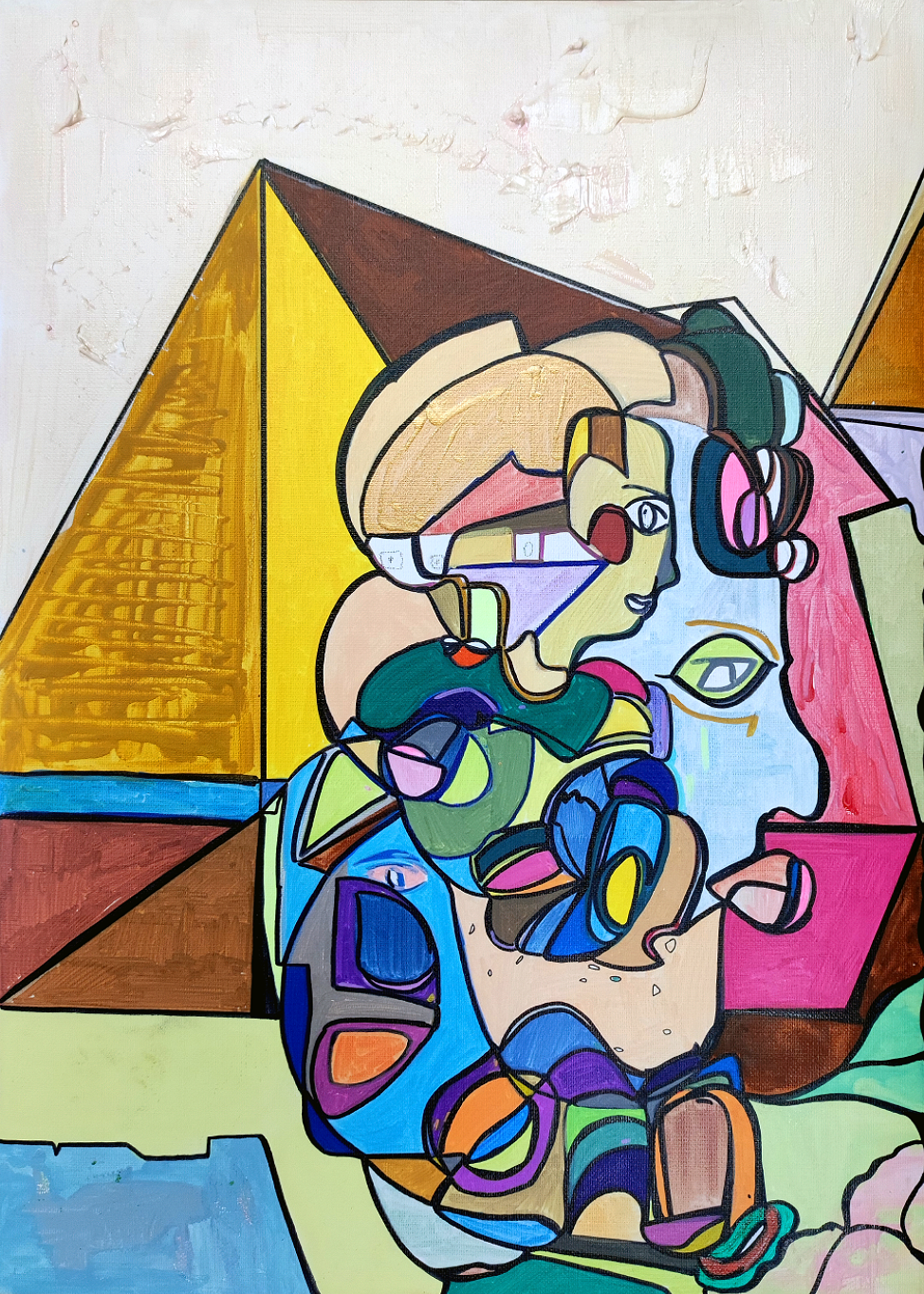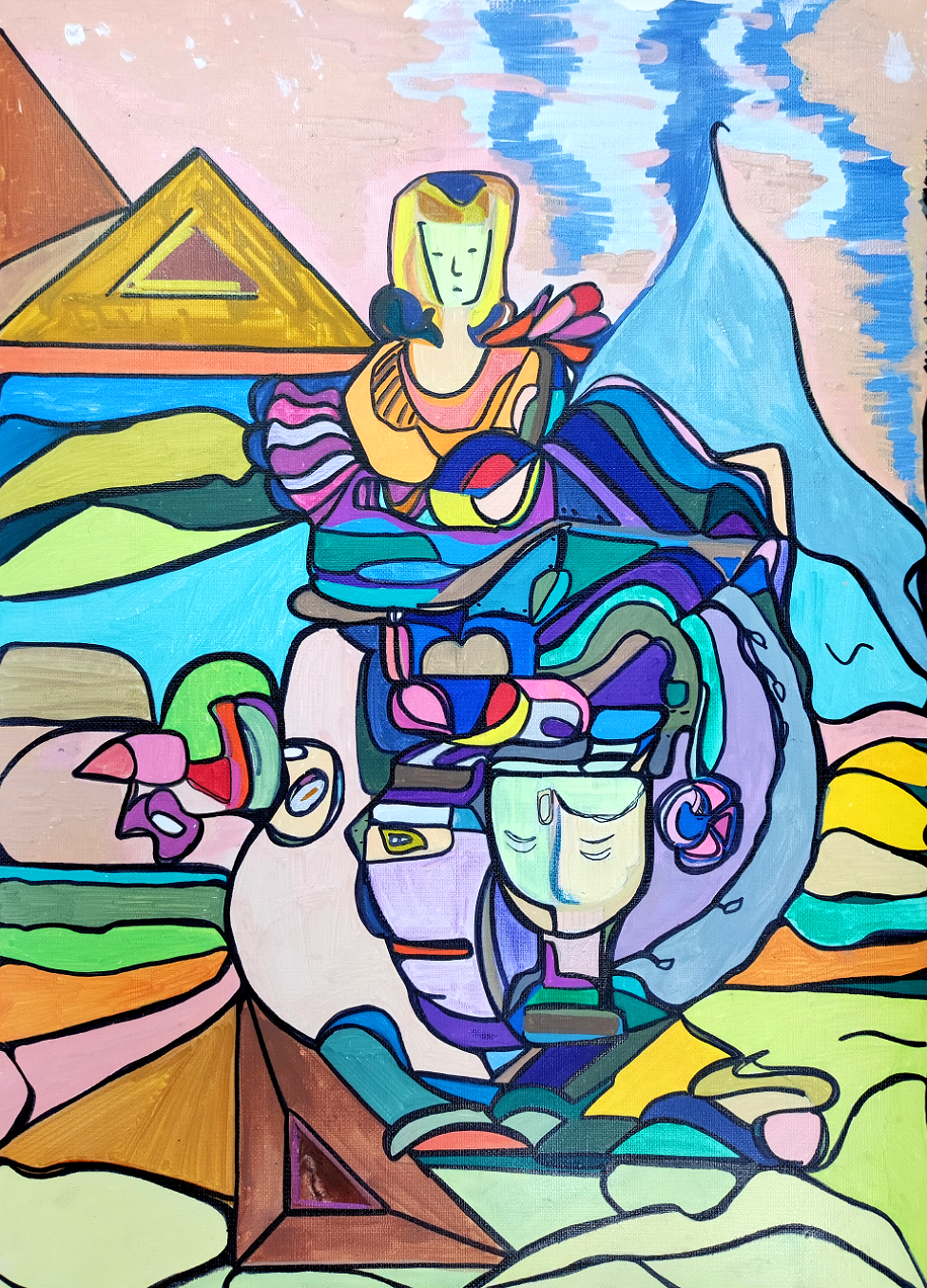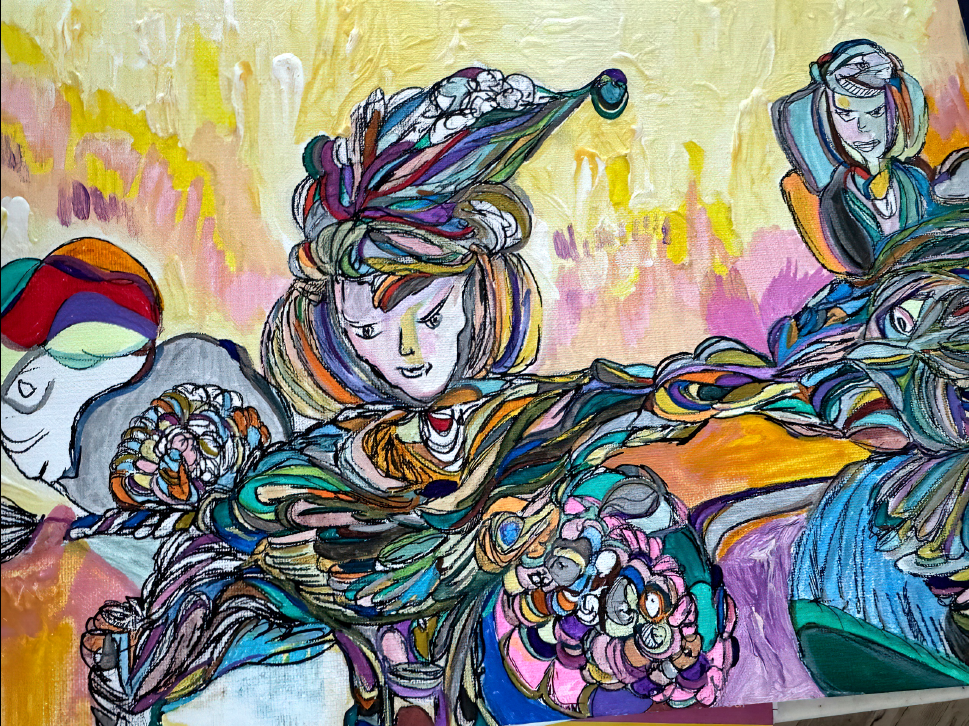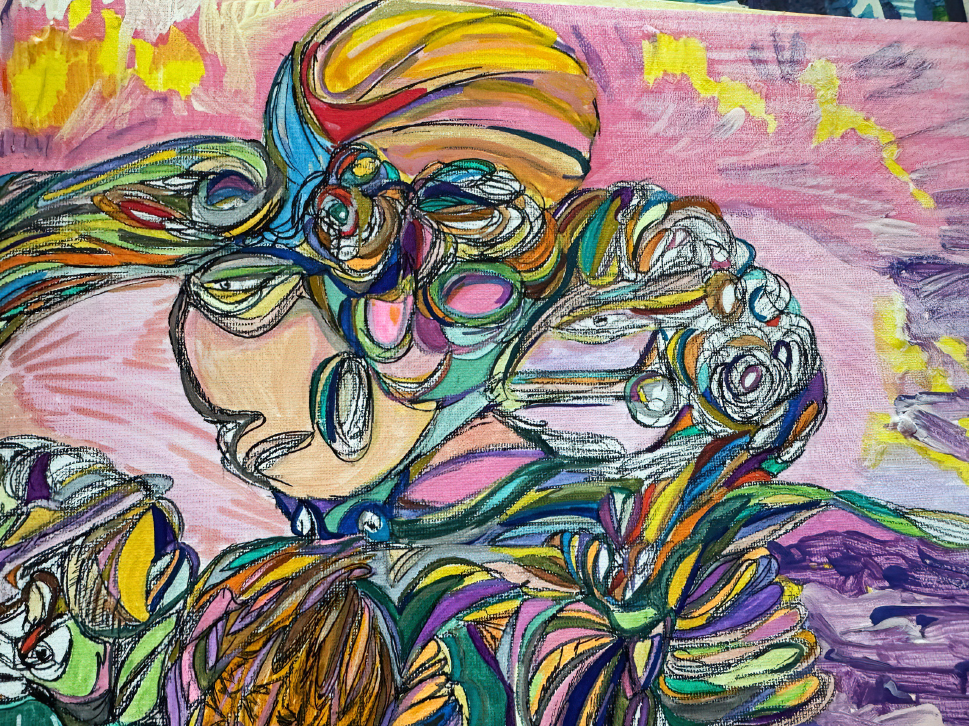Portfolio
More products
40х40 сm
Paper, mixed media
This painting was inspired by my re-reading of Mario Puzo’s «The Last Don,» an American novel that explores the concept of Omerta, a code of silence, honor, and conduct that rejects the influence of the state.
In Puzo’s books, characters are bound by Omerta, emphasizing the secrecy and loyalty within the mafia. However, a lesser-known aspect is the lives of mafia wives who often resided in enclaves purchased by their husbands.
These women, just like their husbands, were bound by Omerta, and it’s intriguing that while men occasionally violated this code, women rarely did. An example from «The Last Don» is when Don Clericuzio’s daughter chose madness over revealing who killed her husband on their wedding night.
In response, her father, brothers, and uncle enforced the code with their own hands, highlighting the deep commitment to Omerta.
Paper, mixed media
This painting was inspired by my re-reading of Mario Puzo’s «The Last Don,» an American novel that explores the concept of Omerta, a code of silence, honor, and conduct that rejects the influence of the state.
In Puzo’s books, characters are bound by Omerta, emphasizing the secrecy and loyalty within the mafia. However, a lesser-known aspect is the lives of mafia wives who often resided in enclaves purchased by their husbands.
These women, just like their husbands, were bound by Omerta, and it’s intriguing that while men occasionally violated this code, women rarely did. An example from «The Last Don» is when Don Clericuzio’s daughter chose madness over revealing who killed her husband on their wedding night.
In response, her father, brothers, and uncle enforced the code with their own hands, highlighting the deep commitment to Omerta.
42,0x29,7
Paper, mixed media
Anton Pavlovich Chekhov, in my opinion, is a writer whose works beckon to be revisited endlessly. He delicately unveils both fresh and simultaneously self-evident dimensions of the human experience. So, upon finishing reading one of his stories, the sad one,
I realized that I want to portray light. Ultimately, there are no situations without hope.
Paper, mixed media
Anton Pavlovich Chekhov, in my opinion, is a writer whose works beckon to be revisited endlessly. He delicately unveils both fresh and simultaneously self-evident dimensions of the human experience. So, upon finishing reading one of his stories, the sad one,
I realized that I want to portray light. Ultimately, there are no situations without hope.
42,0x29,7
Paper, mixed media
Anton Pavlovich Chekhov, in my opinion, is a writer whose works beckon to be revisited endlessly. He delicately unveils both fresh and simultaneously self-evident dimensions of the human experience. So, upon finishing reading one of his stories, the sad one,
I realized that I want to portray light. Ultimately, there are no situations without hope.
Paper, mixed media
Anton Pavlovich Chekhov, in my opinion, is a writer whose works beckon to be revisited endlessly. He delicately unveils both fresh and simultaneously self-evident dimensions of the human experience. So, upon finishing reading one of his stories, the sad one,
I realized that I want to portray light. Ultimately, there are no situations without hope.
Size: 42x29,7 cm
Paper, mixed media
Recently, I finished one of my most significant paintings and decided to name it «Ikigai» — a Japanese concept that means «the purpose of life» or «what makes you get up in the morning.»
Each of us battles with inner demons, and sometimes with external challenges. My painting is about how important it is to start small, appreciate the little things, and be present in the moment. In life, gradual evolution is more important than abrupt revolutions. Small victories on the path to your goal are more valuable than a single rush toward an elusive success.
If you’re interested in the concept of Ikigai, I recommend reading the book by Ken Mogi of the same name.
Paper, mixed media
Recently, I finished one of my most significant paintings and decided to name it «Ikigai» — a Japanese concept that means «the purpose of life» or «what makes you get up in the morning.»
Each of us battles with inner demons, and sometimes with external challenges. My painting is about how important it is to start small, appreciate the little things, and be present in the moment. In life, gradual evolution is more important than abrupt revolutions. Small victories on the path to your goal are more valuable than a single rush toward an elusive success.
If you’re interested in the concept of Ikigai, I recommend reading the book by Ken Mogi of the same name.
More products
59,4 x42 cm
I have two little dogs - Maltese Bologneses named Prada and Chanel. They are half-sisters through their father. So, thanks to Prada, I got to know a wonderful, kind person, Irina.
Here’s how it happened. We decided that Prada should experience all the joys of motherhood. Our dog gave birth to two beautiful puppies: Fendi and Chloe.
Chloe is very special, and she found a home with Irina, a kindred spirit for me
Irina and I live in different cities, have never met, but have spent endless hours talking on the phone. Our dogs are growing up, just like our mutual bond and respect for each other.
That’s how life can sometimes present you with a wonderful surprise
Most importantly, I am endlessly grateful to Irina and her family for all the love and care they show to our Chloe
I have two little dogs - Maltese Bologneses named Prada and Chanel. They are half-sisters through their father. So, thanks to Prada, I got to know a wonderful, kind person, Irina.
Here’s how it happened. We decided that Prada should experience all the joys of motherhood. Our dog gave birth to two beautiful puppies: Fendi and Chloe.
Chloe is very special, and she found a home with Irina, a kindred spirit for me
Irina and I live in different cities, have never met, but have spent endless hours talking on the phone. Our dogs are growing up, just like our mutual bond and respect for each other.
That’s how life can sometimes present you with a wonderful surprise
Most importantly, I am endlessly grateful to Irina and her family for all the love and care they show to our Chloe
59,4 x42 cm
For some reason, in this picture, I wanted to reflect the following distinctive features of this period:
1. Favoritism, the power of official favorites (and favorites).
2. The cult of pleasure as the main principle of life.
3. Gallantry as the basis of male-female relations. This concept included such sharply opposite tendencies as the proclamation of woman as “goddess” and “ruler of thoughts”, and, on the other hand, the use of her as a powerless object, “tool” for pleasure.
Before you is a beautiful representative of this period and a gallant cavalier who bows before her....
For some reason, in this picture, I wanted to reflect the following distinctive features of this period:
1. Favoritism, the power of official favorites (and favorites).
2. The cult of pleasure as the main principle of life.
3. Gallantry as the basis of male-female relations. This concept included such sharply opposite tendencies as the proclamation of woman as “goddess” and “ruler of thoughts”, and, on the other hand, the use of her as a powerless object, “tool” for pleasure.
Before you is a beautiful representative of this period and a gallant cavalier who bows before her....
Size: 29,7x42
Drawing technique: Paper, mixed media
Many in my circle know that I don’t like cut flowers. So I’ve been gifted all sorts of flowers: chocolate, fruit, crystal, and even forged ones. Meanwhile, my mom has turned my apartment into a whole botanical garden. Thankfully, the living space allows for it, but somehow we’ve counted over 60 pots with various plants and trees up to date
Drawing technique: Paper, mixed media
Many in my circle know that I don’t like cut flowers. So I’ve been gifted all sorts of flowers: chocolate, fruit, crystal, and even forged ones. Meanwhile, my mom has turned my apartment into a whole botanical garden. Thankfully, the living space allows for it, but somehow we’ve counted over 60 pots with various plants and trees up to date
Size: 210x297
Drawing technique: Paper, mixed media
My son noticed that I have a habit of watching movies and drawing at the same time. I find it natural and enjoy the process. Here are some of my artworks created while watching «Dune.»
Drawing technique: Paper, mixed media
My son noticed that I have a habit of watching movies and drawing at the same time. I find it natural and enjoy the process. Here are some of my artworks created while watching «Dune.»
More products
Acrylic, paper, mixed media 59,4x42cm
Swift strokes of my brush brought to life a young woman who delicately gathered her memories, weaving them through an ethereal, imperceptible thread into her 'vessel of recollections.'
Yet what she chose to encase within this precious vessel remained an enigma, even to me, for an extended period.
The revelation drew its essence from a Korean folk tale and a reinterpretation of Choi Sagyu's historical drama.
My heroine was from a wealthy family. Her father, greedy for wealth and power, made a fortune, but yearned to marry off his daughter to an even wealthier family. Upon discovering her love for another, he fumed with fury. He dispatched her beloved to the army and engineered a calamity to ensure he never returned, leaving the young man maimed.
When the young woman discovered her pregnancy, she confronted her father, asserting her intent to reunite with her beloved and embark on a distant life together. The infuriated father sought a concoction to terminate the child, yet it tragically cost her sight, leaving her with only darkness.
From that moment, she cut all ties with her family, finding peace in the solitude of the mountains, where she raised her son. He stood as the sole evidence of her boundless love, a beacon that illuminated her life's challenging path.
Remarkably, she didn't let bitterness seize her heart, choosing instead to instill in her son a love for all creation—be it, animals, plants, or people.
In light of this, I titled the painting 'Memory of a Dream'—a blend of dreams which partly came true and a mirage of it...
Swift strokes of my brush brought to life a young woman who delicately gathered her memories, weaving them through an ethereal, imperceptible thread into her 'vessel of recollections.'
Yet what she chose to encase within this precious vessel remained an enigma, even to me, for an extended period.
The revelation drew its essence from a Korean folk tale and a reinterpretation of Choi Sagyu's historical drama.
My heroine was from a wealthy family. Her father, greedy for wealth and power, made a fortune, but yearned to marry off his daughter to an even wealthier family. Upon discovering her love for another, he fumed with fury. He dispatched her beloved to the army and engineered a calamity to ensure he never returned, leaving the young man maimed.
When the young woman discovered her pregnancy, she confronted her father, asserting her intent to reunite with her beloved and embark on a distant life together. The infuriated father sought a concoction to terminate the child, yet it tragically cost her sight, leaving her with only darkness.
From that moment, she cut all ties with her family, finding peace in the solitude of the mountains, where she raised her son. He stood as the sole evidence of her boundless love, a beacon that illuminated her life's challenging path.
Remarkably, she didn't let bitterness seize her heart, choosing instead to instill in her son a love for all creation—be it, animals, plants, or people.
In light of this, I titled the painting 'Memory of a Dream'—a blend of dreams which partly came true and a mirage of it...
59,4 x 42 cm
My young daughter consistently imparts valuable lessons on finding joy in simple moments. For instance, she approaches flower arrangements with genuine delight, meticulously examining each blossom, relishing their fragrances, and immersing herself in their beauty
The capacity to appreciate life's small pleasures brings us happiness. Yet, as we grow older, this ability tends to wane. We often become preoccupied with life's challenges and limitations, gradually losing our emotional responsiveness to the beauty that envelops us. However, our capacity to admire what we see has a huge impact on the quality of our lives.
Within this work, I have captured the essence of Ameliya, my daughter, as she personifies the exuberance of life. She is constant reminder to surrounding her people to perceive the world as a realm of boundless miracles💫
My young daughter consistently imparts valuable lessons on finding joy in simple moments. For instance, she approaches flower arrangements with genuine delight, meticulously examining each blossom, relishing their fragrances, and immersing herself in their beauty
The capacity to appreciate life's small pleasures brings us happiness. Yet, as we grow older, this ability tends to wane. We often become preoccupied with life's challenges and limitations, gradually losing our emotional responsiveness to the beauty that envelops us. However, our capacity to admire what we see has a huge impact on the quality of our lives.
Within this work, I have captured the essence of Ameliya, my daughter, as she personifies the exuberance of life. She is constant reminder to surrounding her people to perceive the world as a realm of boundless miracles💫
Size 42х59,4
One can write a lot about this topic, but I would like to quote Franz Kafka: “If you go along a straight path, willingly and still retreat, then it is a lost cause. But since you are climbing a sheer slope, so sheer that from below you seem to be hanging on it, steps backward can only be caused by the peculiarities of the ground, and you should not despair.”
So it is in life; one should not despair when facing obstacles and should continue moving “On Contrary”...
One can write a lot about this topic, but I would like to quote Franz Kafka: “If you go along a straight path, willingly and still retreat, then it is a lost cause. But since you are climbing a sheer slope, so sheer that from below you seem to be hanging on it, steps backward can only be caused by the peculiarities of the ground, and you should not despair.”
So it is in life; one should not despair when facing obstacles and should continue moving “On Contrary”...
Size: 42x29,7 cm
Paper, mixed media
«Norwegian Forest» is a 1987 novel by the Japanese writer Haruki Murakami.
It was he who inspired me to write this piece.
Love is the main theme around which the action takes place. Together with the protagonist I immersed myself in his memories, where as a student he lived loneliness, various tragic events, but meanwhile all this was an important part of his formation as an adult.
I painted each of the pictures and thus explored the life of each character.
The world is amazing.
The people who live in it are the whole universe.
Paper, mixed media
«Norwegian Forest» is a 1987 novel by the Japanese writer Haruki Murakami.
It was he who inspired me to write this piece.
Love is the main theme around which the action takes place. Together with the protagonist I immersed myself in his memories, where as a student he lived loneliness, various tragic events, but meanwhile all this was an important part of his formation as an adult.
I painted each of the pictures and thus explored the life of each character.
The world is amazing.
The people who live in it are the whole universe.
More products
Acrylic, paper, mixed media 59,4x42cm
Every artist treasures particular paintings, imbued with profound emotion and soul. Allow me to share my favorites
Every artist treasures particular paintings, imbued with profound emotion and soul. Allow me to share my favorites
Paper, mixed media 42x29,7
American singer Ella Fitzgerald is the first lady of jazz, whose vocal abilities amazed even those distant from music. Her three-octave voice, mastery of scat singing, and over 90 albums have left an indelible mark on music history, inspiring artists like myself to create artworks embodying the spirit of jazz.
American singer Ella Fitzgerald is the first lady of jazz, whose vocal abilities amazed even those distant from music. Her three-octave voice, mastery of scat singing, and over 90 albums have left an indelible mark on music history, inspiring artists like myself to create artworks embodying the spirit of jazz.
Paper, mixed media 30x40
The picture captures a woman who is going to war. There is a blue pigeon on the back of her shoulder symbolizing a hope that war will soon end. It is very sad when women, as during the Second World War, went to the front. Let us all pray for a peace 🫶
The picture captures a woman who is going to war. There is a blue pigeon on the back of her shoulder symbolizing a hope that war will soon end. It is very sad when women, as during the Second World War, went to the front. Let us all pray for a peace 🫶
Paper, mixed media 42x29,7
In the mystical lands of Japan, there exists an enlightening legend centered around a dragon.
Long ago, there resided a man whose heart was captivated by the allure of dragons. He made his home within a cavern, akin to the dwellings of dragons, surrounded by sculptures and paintings depicting these majestic beings. He could discourse endlessly about these wondrous creatures to anyone willing to lend an ear.
One fateful day, news of this man and his fervent adoration for dragons reached the ears of the dragon himself. Intrigued, the dragon resolved to meet his ardent admirer. Upon arriving at the man’s cave, the dragon found him fast asleep. Come morning, the man awoke to find a colossal creature slumbering beside him. Gripped by fear, he hastily seized his sword and, without affording it a chance to speak, drove the dragon away.
The essence of this tale speaks volumes: A) Our affection for the concepts we hold often surpasses our love for the realities they represent. B) The dragon symbolizes our genuine selves, which we must summon the courage to confront and embrace.
I’m eager to hear your thoughts on these refinements 🙏☺️
In the mystical lands of Japan, there exists an enlightening legend centered around a dragon.
Long ago, there resided a man whose heart was captivated by the allure of dragons. He made his home within a cavern, akin to the dwellings of dragons, surrounded by sculptures and paintings depicting these majestic beings. He could discourse endlessly about these wondrous creatures to anyone willing to lend an ear.
One fateful day, news of this man and his fervent adoration for dragons reached the ears of the dragon himself. Intrigued, the dragon resolved to meet his ardent admirer. Upon arriving at the man’s cave, the dragon found him fast asleep. Come morning, the man awoke to find a colossal creature slumbering beside him. Gripped by fear, he hastily seized his sword and, without affording it a chance to speak, drove the dragon away.
The essence of this tale speaks volumes: A) Our affection for the concepts we hold often surpasses our love for the realities they represent. B) The dragon symbolizes our genuine selves, which we must summon the courage to confront and embrace.
I’m eager to hear your thoughts on these refinements 🙏☺️
More products
Size: 42x29,7 cm
Paper, mixed media
Well, it’s time to start getting ready for the New Year. I’m already re-reading fairy tales—this time, by Oscar Wilde—and filling my imagination with new imagery.
The author himself didn’t like calling his stories “fairy tales.” In his letters, he referred to them as “short stories” or “prose etudes” for “children aged 18 to 80.” He recommended them to adults who have not “lost the gift of wonder and joy.”
Paper, mixed media
Well, it’s time to start getting ready for the New Year. I’m already re-reading fairy tales—this time, by Oscar Wilde—and filling my imagination with new imagery.
The author himself didn’t like calling his stories “fairy tales.” In his letters, he referred to them as “short stories” or “prose etudes” for “children aged 18 to 80.” He recommended them to adults who have not “lost the gift of wonder and joy.”
Size: 42x29,7 cm
Paper, mixed media
A series of paintings inspired by M. Sholokhov’s novel And Quiet Flows the Don. Just like in the novel, my paintings depict three key characters.
At the center is Grigory, a Cossack who survived World War I, the Revolution, the Civil War, and the Don Cossack uprising. Like many in those years, he fought for both the Reds and the Whites but never truly understood which side held the truth.
On either side of him are two women: Aksinia—a femme fatale and an untouchable proud woman whom he loved; and Natalia, who could never become a beloved wife to her own husband.
Grigory spent his life torn between the two and lost them both. Aksinia died from a stray bullet, and Natalia, after an abortion, cursing her husband.
It makes you want to say to him: “You’ve got a sharp mind, but it belongs to a fool.”
Paper, mixed media
A series of paintings inspired by M. Sholokhov’s novel And Quiet Flows the Don. Just like in the novel, my paintings depict three key characters.
At the center is Grigory, a Cossack who survived World War I, the Revolution, the Civil War, and the Don Cossack uprising. Like many in those years, he fought for both the Reds and the Whites but never truly understood which side held the truth.
On either side of him are two women: Aksinia—a femme fatale and an untouchable proud woman whom he loved; and Natalia, who could never become a beloved wife to her own husband.
Grigory spent his life torn between the two and lost them both. Aksinia died from a stray bullet, and Natalia, after an abortion, cursing her husband.
It makes you want to say to him: “You’ve got a sharp mind, but it belongs to a fool.”
Size: 42x29,7 cm
Paper, mixed media
Fortunately, we have a starting point: a simple reminder that the goal of our life is to find happiness, Zen 🧘♀️
Paper, mixed media
Fortunately, we have a starting point: a simple reminder that the goal of our life is to find happiness, Zen 🧘♀️
Size: 42x29,7 cm
Paper, mixed media
Have you ever wondered who is better: Pushkin or Lermontov? In my youth, I preferred Lermontov, but recently I came to realize that it’s not always necessary to choose just one with a youthful absolutism.
It’s important to stay open to different perspectives and works. Paradoxically, it was a book of Pushkin’s fairy tales that led me to this thought. After rereading several volumes by the great Russian writer, I gained a fresh perspective on his work. And here is the result – my new painting, “Pushkin”
Paper, mixed media
Have you ever wondered who is better: Pushkin or Lermontov? In my youth, I preferred Lermontov, but recently I came to realize that it’s not always necessary to choose just one with a youthful absolutism.
It’s important to stay open to different perspectives and works. Paradoxically, it was a book of Pushkin’s fairy tales that led me to this thought. After rereading several volumes by the great Russian writer, I gained a fresh perspective on his work. And here is the result – my new painting, “Pushkin”
More products
Size of each panel: 42 × 29.7 cm
Medium: Canvas, mixed media
Format: Triptych (3 parts)
Description:
“In Spite of It All” is a triptych dedicated to the theme of a woman’s inner resilience in the face of life’s trials and transformations. The work weaves together cultural memory, personal experience, and spiritual seeking, unfolding the heroine’s journey across three symbolic chapters.
The first panel evokes the image of youth — innocence, purity, and hope. It represents the beginning of her path, when she has not yet been burdened by the weight of the world, yet strives to preserve her inner clarity in spite of early challenges.
The second panel, metaphorically described as “seas and oceans,” symbolizes transition — both physical and spiritual. It speaks of migration, separation, and the search for identity, as the heroine navigates unfamiliar spaces both within and without.
The final panel, “remaining true to oneself,” marks the culmination of her journey. Despite upheavals and change, the heroine preserves the essence of the girl she once was at sixteen. This powerful image reflects feminine strength — the ability to remain rooted in one’s self even amidst profound adversity.
Medium: Canvas, mixed media
Format: Triptych (3 parts)
Description:
“In Spite of It All” is a triptych dedicated to the theme of a woman’s inner resilience in the face of life’s trials and transformations. The work weaves together cultural memory, personal experience, and spiritual seeking, unfolding the heroine’s journey across three symbolic chapters.
The first panel evokes the image of youth — innocence, purity, and hope. It represents the beginning of her path, when she has not yet been burdened by the weight of the world, yet strives to preserve her inner clarity in spite of early challenges.
The second panel, metaphorically described as “seas and oceans,” symbolizes transition — both physical and spiritual. It speaks of migration, separation, and the search for identity, as the heroine navigates unfamiliar spaces both within and without.
The final panel, “remaining true to oneself,” marks the culmination of her journey. Despite upheavals and change, the heroine preserves the essence of the girl she once was at sixteen. This powerful image reflects feminine strength — the ability to remain rooted in one’s self even amidst profound adversity.
Size: 210 × 297 mm
Medium: Paper, mixed media
My path to Buddha began seven years ago, when I realized I hadn’t been running from the world — I had been running from myself. Now, I understand: I’m halfway there. The journey is not easy — inner battles demand more courage than external ones. But it’s worth it.
Gradually, the path revealed itself in seven stages:
Medium: Paper, mixed media
My path to Buddha began seven years ago, when I realized I hadn’t been running from the world — I had been running from myself. Now, I understand: I’m halfway there. The journey is not easy — inner battles demand more courage than external ones. But it’s worth it.
Gradually, the path revealed itself in seven stages:
- Awareness of suffering
- Self-acceptance
- Meditation and mindfulness
- Purification of the mind
- Wisdom and compassion
- Self-realization
- Living in harmony
Size: 210 × 297 mm
Medium: Paper, mixed media
Life is like a sea voyage.
At the beginning, there are many ships around you — friends, family, passing companions. Some help you set sail, others travel alongside you, offering support through the first storms.
But the farther you go into open waters, the fewer remain from the start. Some turn back, others sink in their own storms, and some simply disappear beyond the horizon.
Many choose calm harbors — habits, comfort, a sense of safety. Their ships remain anchored, believing they’ve found peace, without noticing they’ve long since stopped sailing… or truly living.
And yet, there comes a moment when you face the storm alone. That’s when you learn how strong your ship really is — whether it can withstand the blows, whether it will stay on course.
But solitude is not the end. It brings a silence in which the wind can be heard. And if your ship is strong, you will find new shores.
Perhaps even new ships sailing beside you — if only for a while.
Medium: Paper, mixed media
Life is like a sea voyage.
At the beginning, there are many ships around you — friends, family, passing companions. Some help you set sail, others travel alongside you, offering support through the first storms.
But the farther you go into open waters, the fewer remain from the start. Some turn back, others sink in their own storms, and some simply disappear beyond the horizon.
Many choose calm harbors — habits, comfort, a sense of safety. Their ships remain anchored, believing they’ve found peace, without noticing they’ve long since stopped sailing… or truly living.
And yet, there comes a moment when you face the storm alone. That’s when you learn how strong your ship really is — whether it can withstand the blows, whether it will stay on course.
But solitude is not the end. It brings a silence in which the wind can be heard. And if your ship is strong, you will find new shores.
Perhaps even new ships sailing beside you — if only for a while.
Size: 210x297
Material: Paper, mixed media
🍂 Autumn is a time of contemplation.
Its colors — from gold to deep brown — form an endless palette where even the simplest shade glows with hidden depth.
As Pushkin wrote: “A melancholy time! So charming to the eye…”
For me, autumn is not only a landscape but an inner state — a pause, a silence, a preparation for renewal.
This series is my interpretation of the falling leaves: a quiet moment before new growth.
Material: Paper, mixed media
🍂 Autumn is a time of contemplation.
Its colors — from gold to deep brown — form an endless palette where even the simplest shade glows with hidden depth.
As Pushkin wrote: “A melancholy time! So charming to the eye…”
For me, autumn is not only a landscape but an inner state — a pause, a silence, a preparation for renewal.
This series is my interpretation of the falling leaves: a quiet moment before new growth.
More products
Size: 210x297
Material: Paper, mixed media
Part 1
My Enchanted Norwegian Forest holds many secrets.
In its depths live unicorns: some dissolve into blue ripples, like reflections in water, while others flare with golden light, like the sunrise on northern slopes.
Material: Paper, mixed media
Part 1
My Enchanted Norwegian Forest holds many secrets.
In its depths live unicorns: some dissolve into blue ripples, like reflections in water, while others flare with golden light, like the sunrise on northern slopes.
Size: 210x297
Material: Paper, mixed media
Part 2
They appear only when
the world falls silent and still.
To remind us:
✨ miracles are always near.
And meeting them is a touch of a fairy tale
that lives within each of us.
Material: Paper, mixed media
Part 2
They appear only when
the world falls silent and still.
To remind us:
✨ miracles are always near.
And meeting them is a touch of a fairy tale
that lives within each of us.
Size: 20×30
Material: Paper, mixed media
Part 1
My new series of works emerged after discovering Amitav Ghosh’s trilogy — Sea of Poppies, River of Smoke, and Flood of Fire. Reading it in one breath, I felt as if I had unlocked an entire layer of imagery within myself. The characters began to appear on paper almost by themselves — numerous and each carrying traces of a historical era.
ACEILLE
Material: Paper, mixed media
Part 1
My new series of works emerged after discovering Amitav Ghosh’s trilogy — Sea of Poppies, River of Smoke, and Flood of Fire. Reading it in one breath, I felt as if I had unlocked an entire layer of imagery within myself. The characters began to appear on paper almost by themselves — numerous and each carrying traces of a historical era.
ACEILLE
Size: 20×30
Material: Paper, mixed media
Part 2
I was deeply moved by the theme of the “ordinary person” caught in the whirlwind of great events — individuals trapped in the grip of the Opium Wars, colonial policies, and the collapse of familiar ways of life. In my paintings, they emerge as multilayered figures and lines striving to preserve themselves amid the chaos of shapes and colors.
For me, this series is a way to infuse painting with literary and historical impressions — to transform what I have read into visual images where the real and the symbolic intertwine.
ACELLE
Material: Paper, mixed media
Part 2
I was deeply moved by the theme of the “ordinary person” caught in the whirlwind of great events — individuals trapped in the grip of the Opium Wars, colonial policies, and the collapse of familiar ways of life. In my paintings, they emerge as multilayered figures and lines striving to preserve themselves amid the chaos of shapes and colors.
For me, this series is a way to infuse painting with literary and historical impressions — to transform what I have read into visual images where the real and the symbolic intertwine.
ACELLE
More products
Size: 210x 297
Medium: Paper, mixed media
When I began this series, I was drawn not only to the form and the stone, but to the people behind them.
I started with the Pyramid of Djoser — the first in history. It was created by Imhotep, an architect and priest. But in my work, the central figure is neither him nor the pharaoh.
It is the one who laid the first stone.
The one who fell from the scaffolding.
The one who became part of eternity — not by choice, but by fate.
ACEILLE
Medium: Paper, mixed media
When I began this series, I was drawn not only to the form and the stone, but to the people behind them.
I started with the Pyramid of Djoser — the first in history. It was created by Imhotep, an architect and priest. But in my work, the central figure is neither him nor the pharaoh.
It is the one who laid the first stone.
The one who fell from the scaffolding.
The one who became part of eternity — not by choice, but by fate.
ACEILLE
Size: 210x 297
Medium: Paper, mixed media
Somewhere beyond the visible, among forgotten paths and starry patterns, there lives a world where miracles don’t shout — they whisper.
This series was born from the pages of Michelle Harrison — as if the book opened and released the breath of a spell into the world.
Medium: Paper, mixed media
Somewhere beyond the visible, among forgotten paths and starry patterns, there lives a world where miracles don’t shout — they whisper.
This series was born from the pages of Michelle Harrison — as if the book opened and released the breath of a spell into the world.

